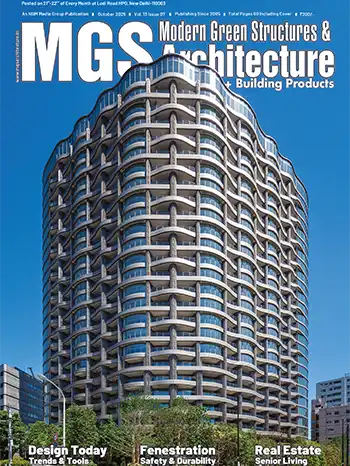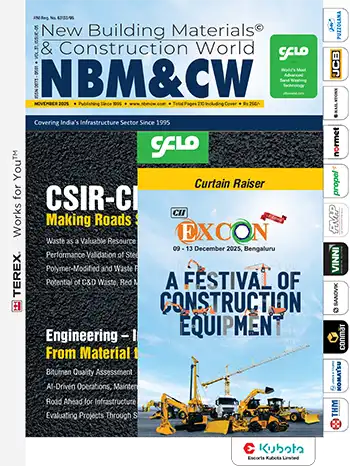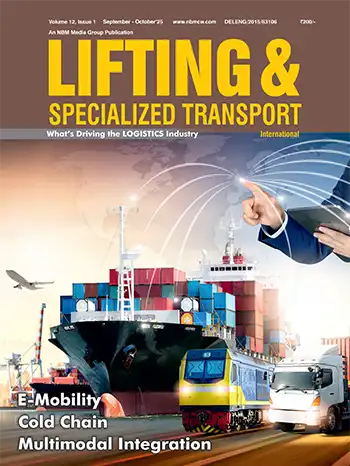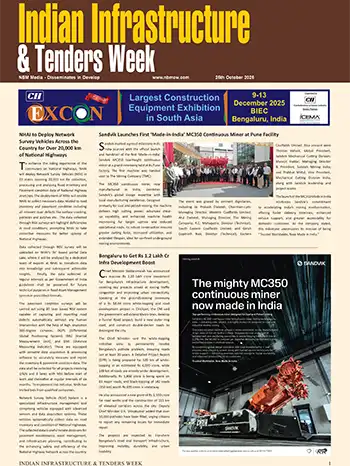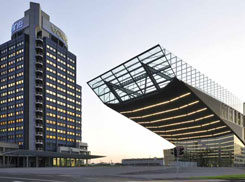
Voestalpine New Sales and Financial Centre, Austria
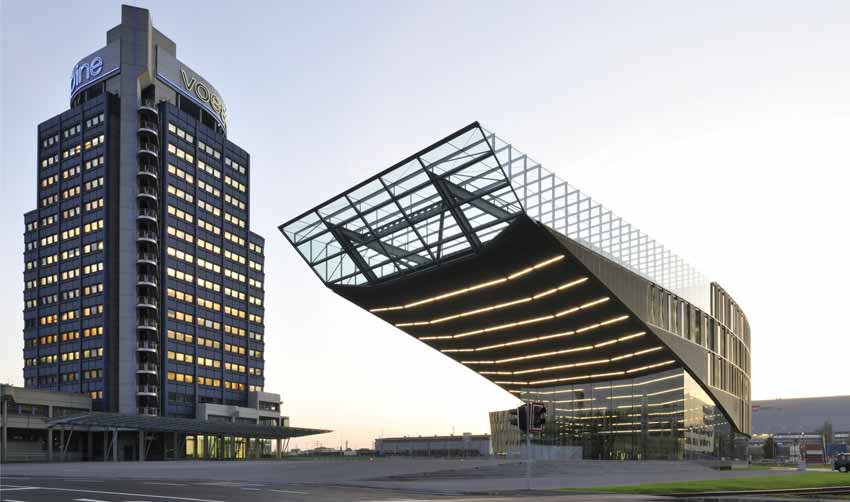
Paris based Dietmar Feichtinger Architectes' has erected the new Financial and Commercial Department of Voest Alpine Stahl GmbH in Linz, Austria. This new sale and financial centre and the existing building 'Blue Tower' together form the portal to the site of voestalpine: two mutually complementary structures as a symbolic representation of the complementary units of voestalpine.
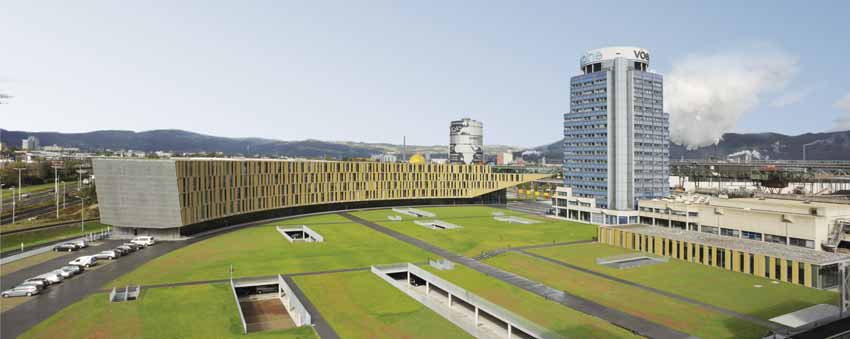
The new building and the existing tower are in a dialogue that clearly defines the opposite of the vertical element of the blue tower to the horizontal shape of the new sales and financial center (VFZ). The wide overhang of the head of VFZ symbolizes the industrial ambitious claim of modern innovative and efficient company.

The entrance with gently sloping surface guides staff and visitors into the building with the addition of LEDs to light the way. Glass and steel are predominant offering transparency and strength across the 23,160 sq m built up area. The entrance of the blue tower is also renewed which is facing the new building.
Entrance
The main entrance to the sales and finance office lies, impossible to overlook below a daring cantilever that exploits steel's structural possibilities at the north-eastern end of the building. Here entirely glazed entrance hall focuses the attention of visitors from the steel reception desk on the one side to the impressive landscape of cranes, waste heaps, and chimneys on the other.
From here a panorama lift takes you to the meeting rooms, accessible to a wider public, that are located in this part of the building. In terms of number, size and fittings these rooms respond to the needs of the location Linz as a whole and are augmented by a terrace on the top floor, surrounded by glass walls and open to the sky, which offers exceptional views. All the rooms on the ground floor, which is clearly shaped as a plinth and has a delicately profiled glass façade, are also reserved for "public" functions such as the company's own travel agency, shops, library, documentation.

Structural Design
Transversally the building is divided in 3 zones: the lateral zones of the offices, a central zone serves for meetings, and Inner atriums.| At a Glance | |
| Location | : Austria |
| Client | : Voest Alpine Stahl gmbH A - 4020 linz |
| Start of construction | : 08 | 2007 |
| Completion | : 06 | 2009 |
| Architect | : Dietmar Feichtinger Architectes, |
| Floor area | : Office 17084 m² Livraison 1238 m² Parking 32260 m² |
| Cost | : 46 400 000 ð HT |
| Photographer | : Josef Pausch |

Dietmar Feichtinger Architectes display the steel construction – columns and open web beams, as well as the concrete of the ceiling slabs. The building services which run only above the corridors can be made out behind their expanded metal cladding. The discipline that this demanded in both design and execution adds a further level of quiet elegance to the overall impression, something that, unfortunately, one can often look for in vain in many a palatial office block.

In addition, the new centre provides a generous open public space covering a one storey parking deck. The spacious garden creates a designed outdoor area for employees and visitors of the company: a sequence of green fields, wooden decks, paved and planted areas structured by patios.
Materials used
The building is designed as a steel structure: Steel frames distanced by 10m50 carry a concrete slab. The columns are in the centre of the building, the side areas are carried by cantilever beams. This configuration offers a large flexibility for office division. The concrete slabs are kept visible. They provide the mass necessary for thermal comfort. An integrated steel truss allows the free cantilever in the front of the building.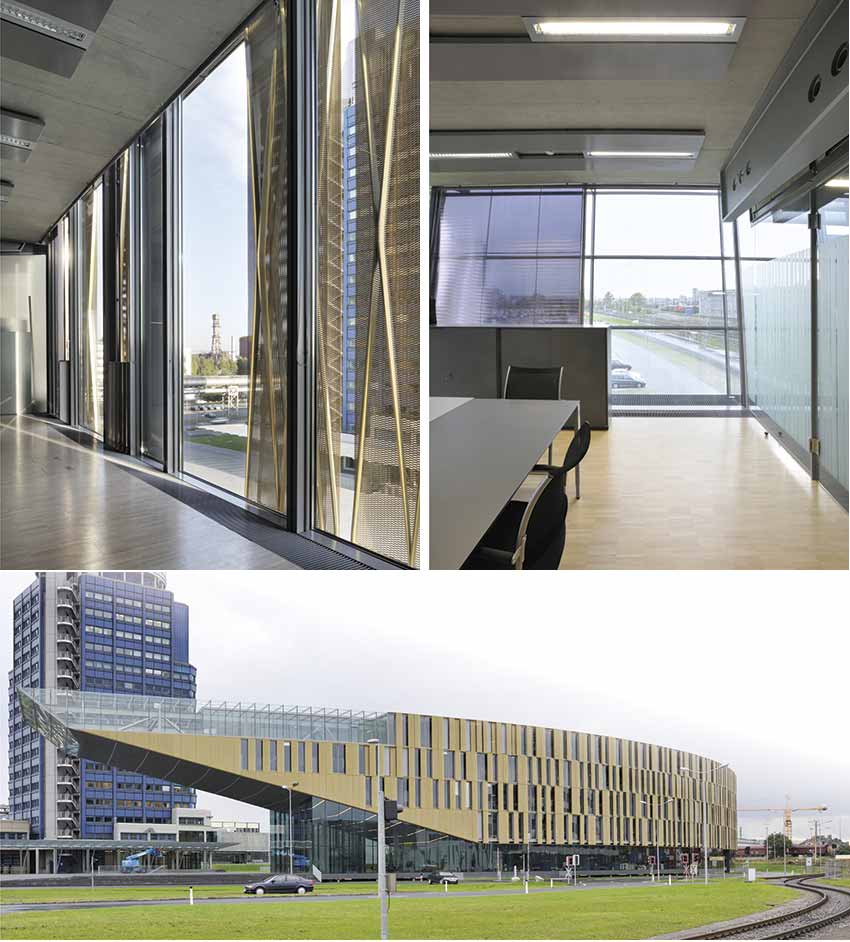
The facade
The façade is largely transparent providing sufficient natural light for the 20m50 wide building. Opaque horizontally sliding openings allow natural ventilation. Shading is assured by motorized steel elements made of a golden coloured steel mesh.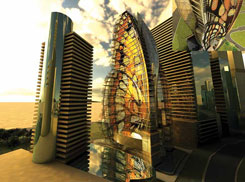
Desert Butterfly
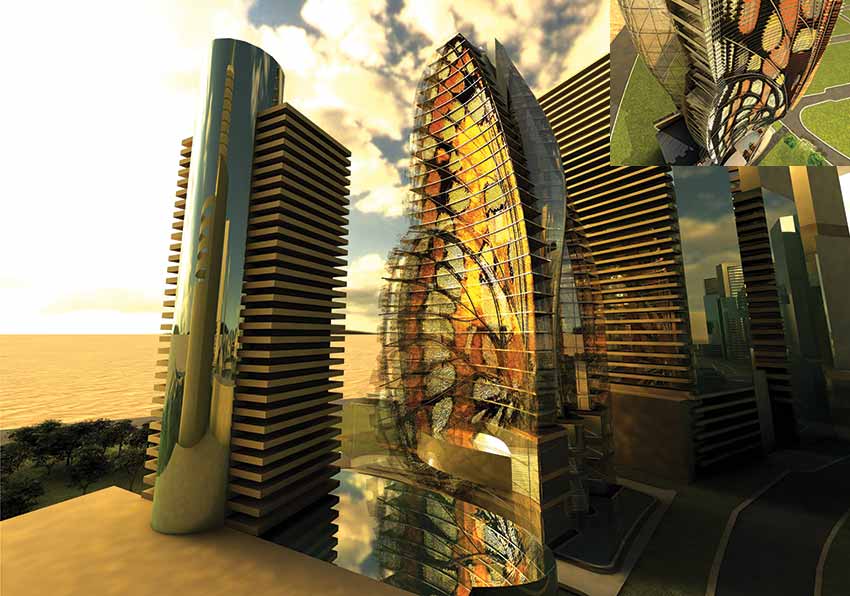
Designed for Al Majan, off Emirates Road, Dubai, The Desert Butterfly is a unique project developed by architectural firm Steelman Partners after having keen observation on the forms and patterns of butterflies.
The project is a unique and luxurious, thirty-seven story, 5-Star hotel; consisting of a single tower with a variety of hotel rooms (single, double, suites, etc.), a grand lobby, a ballroom with separate drop-off, all day dining, feature restaurants, meeting rooms, a pool with gym and spa, a bar / pub, main kitchen, administration offices, hotel back-of-the-house, and three basements of parking for guests, staff, and services.
Design
The design was inspired by the magnificence of a butterfly. The root idea for the lobby ceiling sculpture of The Desert Butterfly developed from observing forms and patterns of several butterfly wings, and cocoons. From that base, the ceiling sculpture steadily matured into its own iconic personality and took flight. A nature-based, intuitive and artistic sense steered the design, with broad strokes creating fluid form. An organic figure developed…the expression of a wing in flight was liberated. How wings glide through the wind and are touched by light had a natural influence on the structures' silhouette.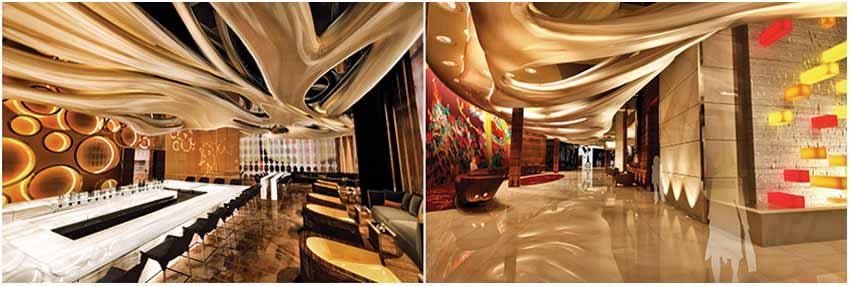
| Location | : Al Majan, off Emirates Road in Dubai |
| Built up area | : 70,000 SM |
| Client | : Al Hamad Engineering Company, Dubai |
| Cost | : $116,000,000 US DOLLARS |
| Status | : Designed. Construction started then stalled due to the economy and the status of Dubailand |
| Architect | : Steelman Partners |

The exterior design utilizes a multi– layered skin that includes a glazing system with ceramic frits to reduce and control light and heat penetration. A B. Louvre system provides a secondary shading device. In addition, a C. Ribs holding tertiary system of scales is employed to further filter undesirable environmental factors. Through this multi–layered skin system, the building can adjust and adapt to harsh environmental aspects of site and location. Optimal light levels can also be adjusted and allowed in as desired. The skin system also houses and supports nightly light shows that transform the structure through slow changes in illumination intensity and hues - bringing the casing to life and metamorphosizing before spectators' eyes.
Distinctive Features
Each of the restaurants provides distinctive offerings to the guests. The Italian dining facility is modern, with unexpected details that play off of the art and movement in the interior. The exposed, all-stainless steel chef kitchen magnifies the dynamic space by bringing the dining experience to a more interactive-level. The Steakhouse design is inspired by the Arabian moon-lit sky. Textures and movement reflected in the walls and throughout the ceiling pay homage to the fluid and graceful nighttime atmosphere and ethereal glow of the moon. The Asian restaurant brings the concept of Tokyo and Hong Kong's bright lights and billboard skyline into the space through the dynamic LED ceiling, creating a unique dining style all its' own. The 3 meal dining option offers a melting pot of cultures cradled into a timeless and simple design that captures the effortlessness and harmony envisioned by its clean lines and crisp textures.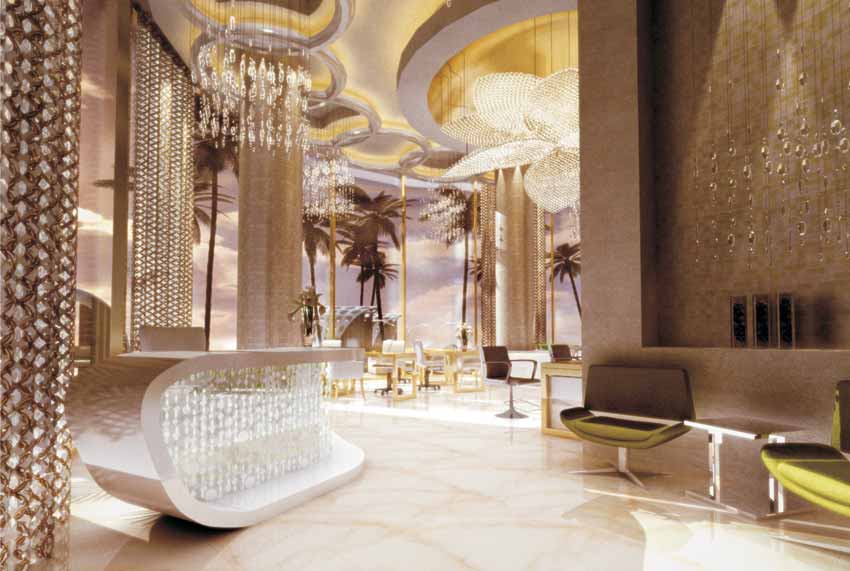
The Mediterranean restaurant is designed in white on white with a splash of tan. Moved by the desert tan cliffs and white terrace homes on the Mediterranean coast, the design creates an open and airy nostalgia as it relates to the serene pool deck just outside. Lastly, the black on black nightclub is the cocoon - textured in a metal pattern of the butterfly. The design touches on the contrasting nature of enclosed space within a larger whole through the nesting of the VIP pods and entertainment spaces.
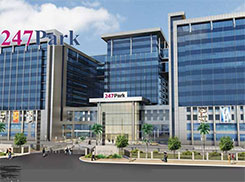
247 Park-Sets New Standards for Green Buildings

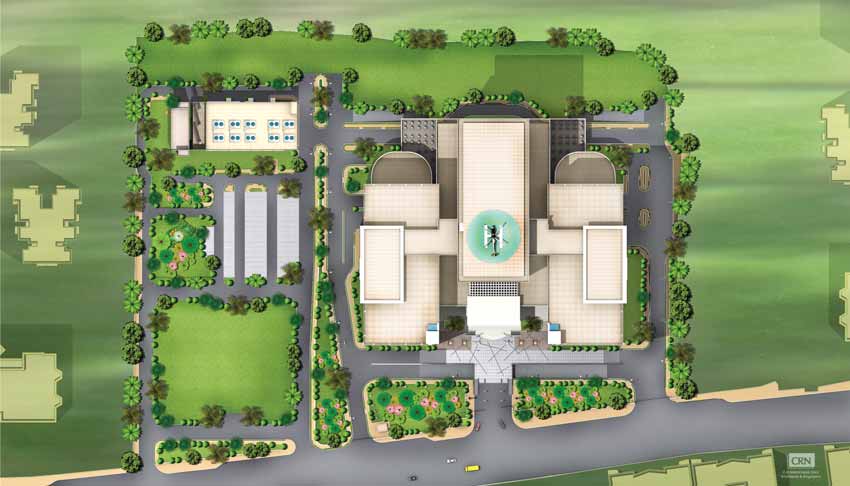
247 Park, a New Age business destination in Mumbai has recently received the prestigious Leadership in Energy and Environmental Design (LEED) Gold Certification for its Green Building design.
Located in the heart of the upcoming IT corridor on LBS Marg, Vikhroli (West) in Mumbai which has become the preferred destination for major corporate houses, the 247 Park® comprises a total of 18 lakh square feet of built-up space stretching over three towers. Designed by Chennai based architectural firm C. R. Narayana Rao and Associates and developed by HCC Real Estate Ltd, a 100% subsidiary of HCC, the 247Park® has become India's largest stand-alone Green Building with the largest combined floor plate of one lac sqft of high end office space.

LEED Gold Certification
The 247Park® has received an occupation certificate from the Municipal Corporation of Greater Mumbai (MCGM) and also recently received LEED Gold certification (Leadership in Energy and Environmental Design) for being a green building adhering to all stipulated efficiency and quality norms incorporated for energy usage, intelligent lighting, water management, indoor environment and materials and resource usage while adopting an innovative design and processes.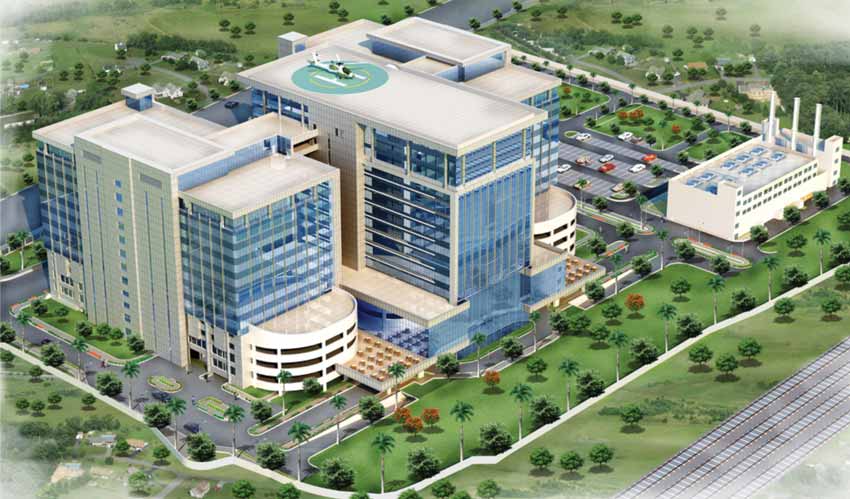
The LEED Gold certification has been established by the United States Green Building Council (USGBC) and verified by the Indian Green Building Council (IGBC). The certification, which adopts the most stringent criteria and rigorous evaluation methods, is the world's foremost recognition of environment-friendly constructions. By using less energy and water, LEED certified green buildings save money (for tax-payers and for their families as much as for businesses), reduce greenhouse gas emissions, and contribute to a healthier environs for residents, workers and the larger community living in its vicinity.

The advanced standards of 247Park optimise comfort and utility thereby making it one of the most environment-friendly buildings in Mumbai and the largest stand-alone commercial complex in India to be awarded this prestigious gold certification. 247Park is equipped to fully recycle all waste materials. "The systems installed will ensure that it will consume 24% less energy as compared to the conventional designs."
Green Designs
The 247 Park building is well connected by road and rail - 1.5 km from Vikhroli and 0.5 km from Kanjurmarg suburban Railway Station and 2 km from the proposed Metro Rail station at Ghatkopar. It is also easily accessible from the domestic airport (12 kms) and international airport (15 km) as well.The 65 meters tall complex also houses a helipad on its roof top. The exteriors of the building are developed using double glazed fenestration oriented methods with inert gas filling to eliminate sound pollution, minimize heat gain and maximize day-light from the windows to reduce power consumption by up to 25%.
It also uses top-of-the-line Membrane Bio Reactor (MBR) technology for sewage treatment. This technology reduces the frequent maintenance of the plant. The water is recycled, brought to almost potable grade and used for chillers and landscaping. Thus this is the first commercial complex with zero discharge–which means that this complex does not require any drainage system connection from MCGM line for sewage disposal. The treated solid waste is the only disposable material that will be collected by MCGM on regular basis. It also has a storm water management, rain water harvesting and an independent utility building providing the required backup support to the entire complex. Effective separation of dry and wet garbage has been done to facilitate recycling of dry garbage and on-site composting of wet garbage which would be used in the landscaping.
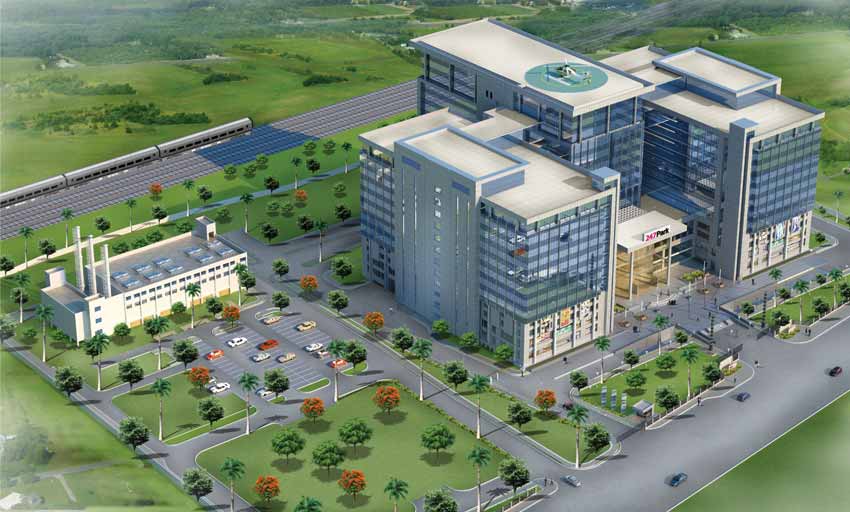
The complex is divided into three towers, with the central tower housing 14 floors of office space and the two adjoining towers housing twelve floors each of office space. The complex has intrusion-free separate access to the office areas with 25 lifts leading right up to the corporate section. In the retail section, there are two floors dedicated to high-end, home store shopping and three levels of covered car parking that accommodates over 1200 cars. The retail section is equipped with escalators, travelators, scenic lifts and separate goods lift for quick and easy movement of goods and customers. Special ramps have been provided to ease the entry and exit for the physically challenged visitors in the corporate office and retail sections.
Tailor-made to the needs of its discerning customers, the 247Park® has also been equipped with a gymnasium, business centre and conference facilities, separate drop– off points for office and retail vehicular and pedestrian traffic, banks and ATMs, high-end restaurants and a 24/7 food court with exclusive terraces. Contemporary surveillance and security measures include round the clock CCTV surveillance in key areas including the car park and common areas. The entire complex has been equipped with state-of-the-art fire detection, alarm and fire fighting systems. The security system is enhanced by a unique car-scanning facility installed at the main entrance which would raise the alarm in case of the presence of explosives and also collect the data such as driver's face, number plate in a flash without having to form large queues of vehicles.
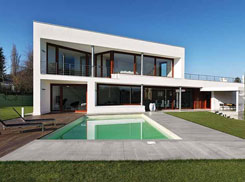
Damilanostudio Architects and B-House

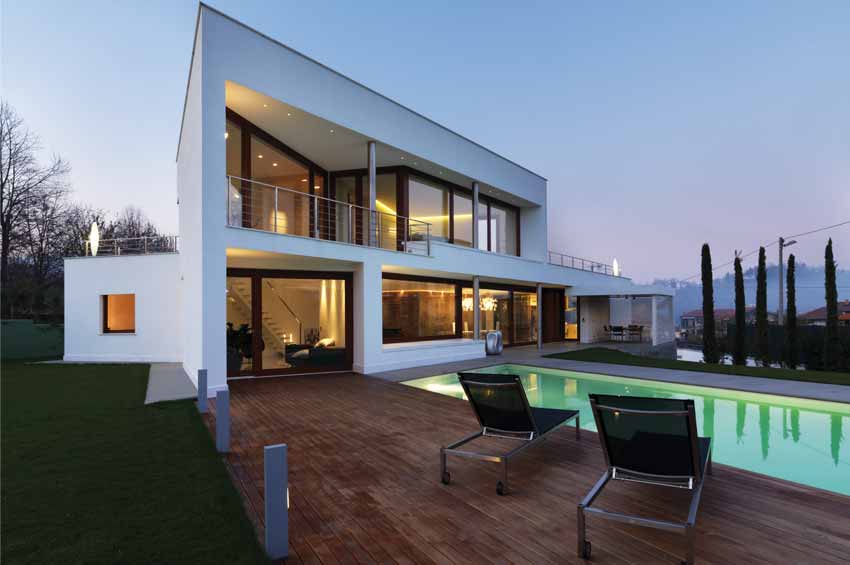
Practise Damilanostudio Architects is named after its founder Duilio Damilano who moved from the Polytechnic of Turin to Milan, in order to attend a workshop by Daniel Libeskind, where he has developed the concept of architectural research directed towards the concreteness of space.
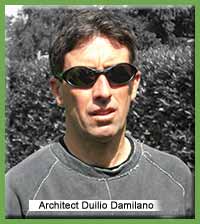
| B-House | |
| Location | Cuneo, Piemonte, Italy |
| Project type | Residential house |
| Status of the project | Completed |
| Team project | Diamilanostudio Architects |
| Architect | Duilio Damilano + Claudia Allinio |
| Structural Design of the project | Arch. Massimo Aimar |
| Photographer | Andrea Martiradonna |
| Surface area | 1080 sqm |
| Surface building | 355 sqm |
| Yea of Completion | 2008 |

After graduating he began his professional career as an Associate and in 1990 he opened the Damilano Studio. Over the years his work has developed, through collaborations with artists and designers, into new architectural paths. Major areas of interest of Damilano Studio are the design of residential buildings, offices and commercial and receptive structures, both in Italy and abroad. Currently, he is working in collaboration with the architects Claudia Allinio, Alberto Pascale, Corrado Tesio and Jessica Pignatta.
Located in Cuneo, Italy, Damilano builds this Italian white house on the hillside to enjoy the landscape of the Piedmont. An open front characterizes B-HOUSE, a refuge without secret where inhabitants are offered views of the landscape from the mountains. The house extends horizontally with a row of premises that end up with the kitchen, real field glasses pointed to the village. In opposite directions, this house develops northwards with the body of the rooms more intimate and intimist and southward with the swimming pool, a wide sheet of water, reflections and light.

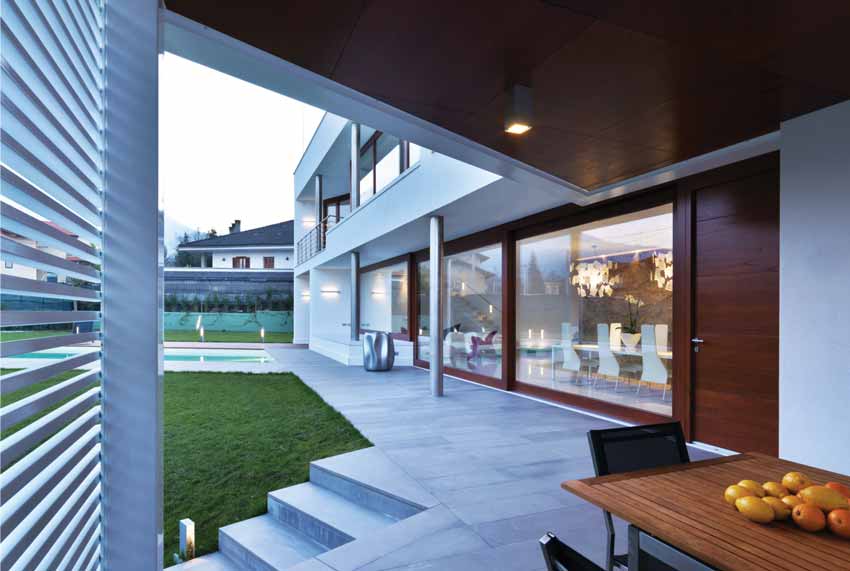
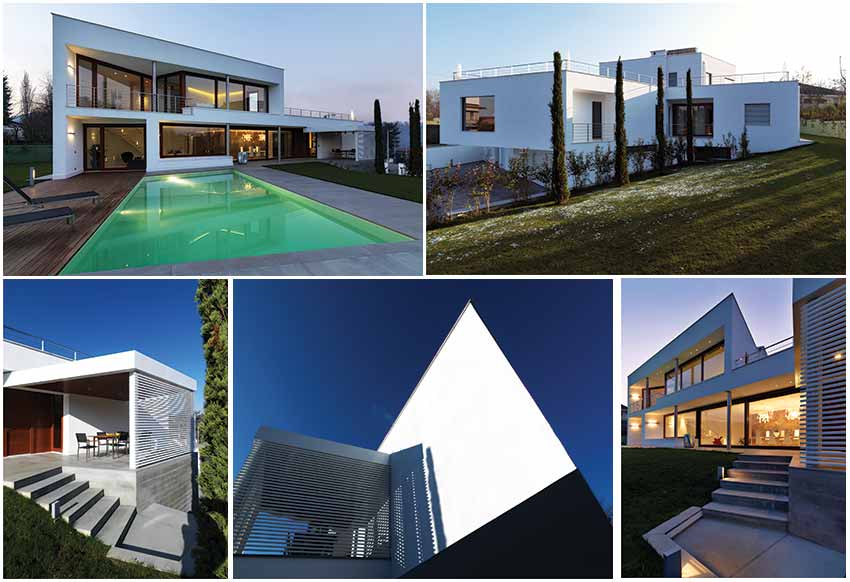
Sustainable Features

- Structure in brick-cement
- Installation of floor heating with accumulating and condensing boiler model ATAG (27000 Kg/cal)
- Exterior wall: double course (interior course portion 20 cm, air space 10 cm which is placed on board insulation made with 4 + 4 cm wool glass density 40 kg/m3, exterior course brick thickness 12 cm);
- Production of hot water with solar thermal vacuum tube "termomax"
- Low emissivity glass [k<2] glass 4+4mm, air space 15 mm, glass 4+4 mm
- Dehumidifying Plaster
Building Materials used:
- Exterior floor: Indian grey stone
- Interior floor in the living room white: Taxsos
- Wall paneling in the living room: Forest Brown
- Interior and exterior wood floor: teak
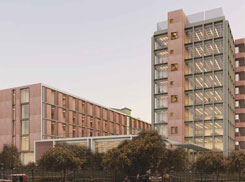
National Council For Applied Economic Research
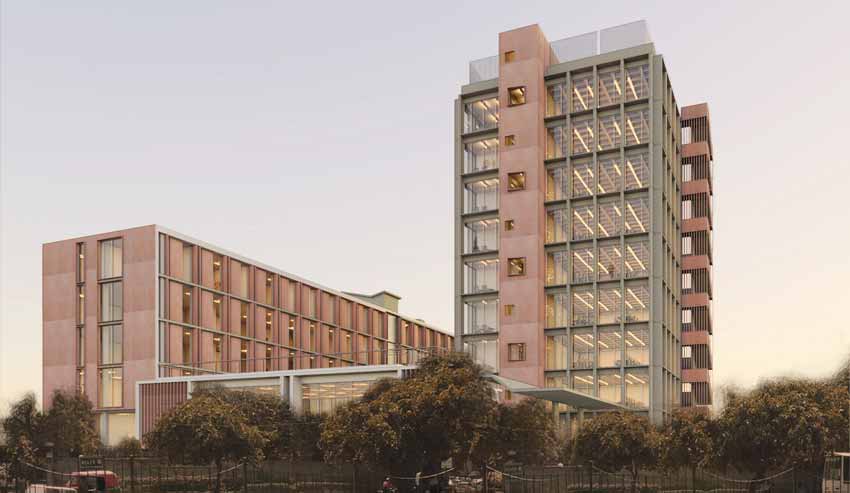
| At a Glance | |
| Project | : NCAER |
| Location | : New Delhi, India |
| Area | : 132,015 sq.ft |
| Achitect | : vir.mueller architects |
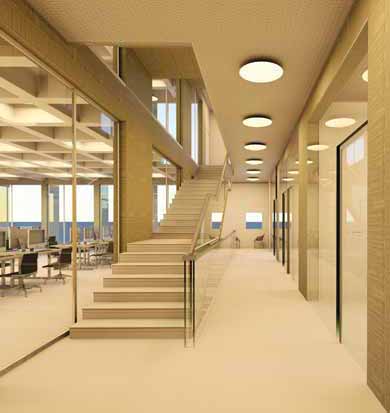
The location of the campus on the banks of the Yamuna River give it an unparalleled vantage point close to the centres of India's executive and parliamentary power, its judiciary, its major national newspapers, and New Delhi's central commercial area of Connaught Place.
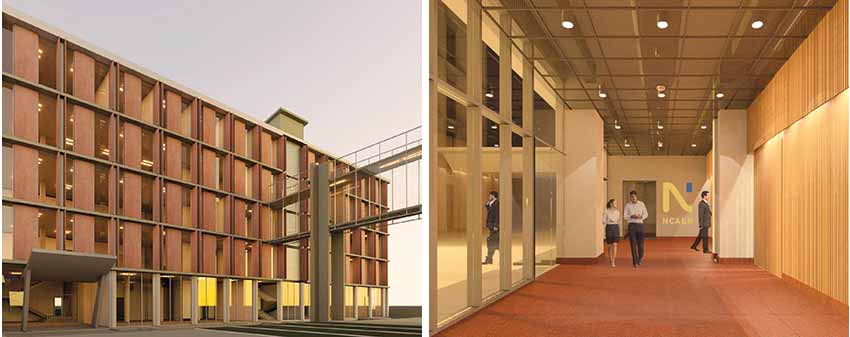
The new NCAER campus will be a GRIHA certified 'Green Building' with ecologically conscious design strategies in place. The building orients the open office spaces towards the North and East, thereby optimizing solar performance and urban views. The service zones are located towards the West, acting as thermal buffers. The use of recessed windows with insulated glazing systems provides protection from direct sun and glare.
The entire workspace is naturally daylit; the use of automatic sensors to control lighting helps further maximize energy efficiency. The building envelope, and glazing systems comply with ECBC norms. The renovation of the existing building retains the existing structural system. The use of Solar Photo Voltaics shall generate renewable energy. The landscaping strategy retains existing trees on the site.

Swarajya Bungalow by Sunil Patil

| At a Glance | |
| Project | : Swarajya Bungalow |
| Location | : Pune, India |
| Area | : 335.42 sq.mtr |
| Achitect | : Sunil Patil & Associates |
Normally, We do not like to go for G+2 floors in a house but restrict it in just Ground + one floor as it has an instant cosiness, a sense of a home, forges interaction between family members and is human in scale. Yet as the plot area was of 335.42 sq mts, it compelled to keep the design a ground plus two storey home as the client required a spacious home for three generations of family members.

It was a typical assignment for an urban client- the plot was small and requirements were significant. The client needed a four bedroom home-a bedroom for the grandparents on the ground floor for easy access, a master bedroom and a bedroom each for their sons, along with formal and informal living spaces including home theatre space and gym spaces; and terraces to enjoy the outdoors. So the design was kept vertical, and with this came the challenges of creating the interactive spaces between three levels, and a feel of a bungalow."

Given the need to design two higher levels, the primary concern was the residence with a built up area of 328.87 sq mts that left a narrow space around the structure, should not appear like a solid heavy uninviting mass. Hence, the terraces were designed not only to cater to their functional need of open air outdoor seating but also to create the interesting cut outs in the solid facade creating excellent compositions of solids and voids. The railing designed with plane glass,added to the purpose.
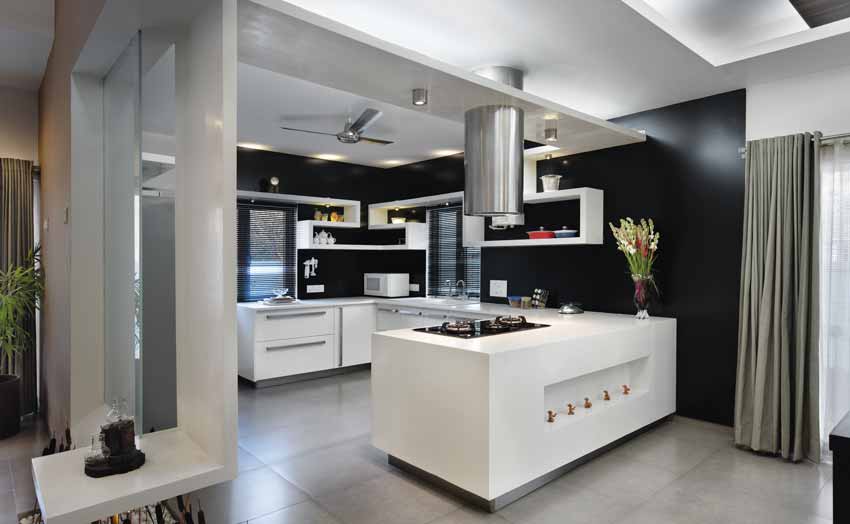
Formal living room is designed in the heart of the home with a double height that instantly gives it a sense of space and connects it with the spaces around and the floors above. Around this space is an informal living room on a slightly raised platform with wooden flooring set in a niche; the kitchen; dining area; utility and storage areas; and the stairs leading to the basement and floors above. Each of these areas is a part of the whole with minimum walls dividing them.
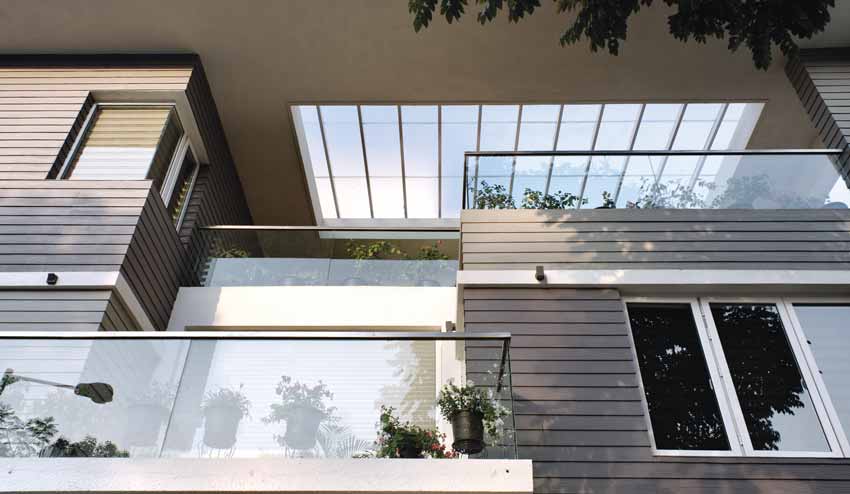
White walls, grey stone cladding on the wall adjoining the informal living space that complements the grey flooring, white kitchen cabinets with an unusual black dado which is designed unconventionally with aluminum composite panel, large glass doors that lead to the greenery outdoors and bring in light and breeze enhance the sense of space. There are no higher level cabinets in the kitchen. A platform which flows through the end of a wall of the kitchen to the living forms a partition and serves multiple purposes by creating space for keeping cookery and being part of the interiors as well. The kitchen has been designed in a highly contemporary style with the black and white theme.
The first level has the master bedroom, one of their son's room, the home theatre area and a spacious terrace with lovely flowering plants. Both the bedrooms have simple neat furniture in the form of low built-in beds with headboards, and long low units that double up as storage, seating or display spaces, walk-in closet space adjoining the bathrooms for convenience of dressing. The headboard of bed runs the length of the bed curves up and down to morph into a seating space facing a television; yet if relaxing on the bed, the backrest of the seating area does not obstruct the view.
The family-cum-home theatre space, a matrix of grey and white with subdued lighting of spot lights or natural lights adjusted through broad blinds is a peaceful private spot to watch a film or simply relax. Blinds–rather than fabric curtains-give a contemporary look to a space and also offer the option of different light effects as they can be opened or closed as per the requirement. A set of narrow wooden bands run on the wall behind the screen and then cross to form geometrical patterns on the ceiling adding a touch of interest.
The higher level has the other sons room once again with a built-in bed yet with a patterned headboard and a walk-in closet. There is also a spacious recreational space for a gym or indoor games with an adjoining terrace; this space also has a small work surface and cabinet for the client to study cases in the quiet of the night. Different shades of veneer have been used in different rooms to give each one a slightly different look, yet one veneer throughout one room to keep the design simple and easy.
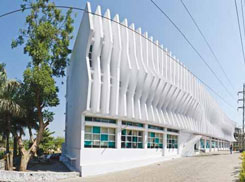
RyeWood International School
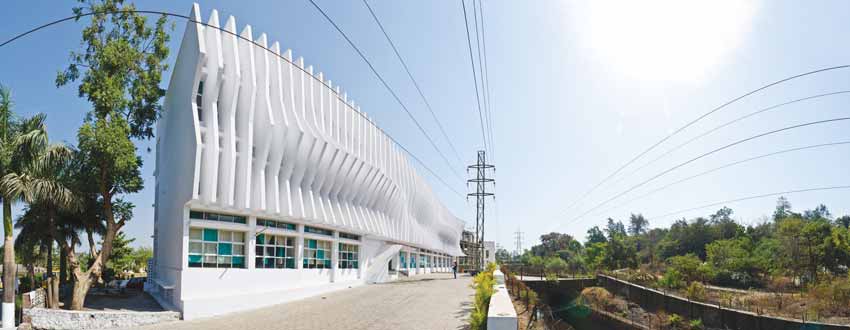
| Project Info | |
| Site | : Lonavala, Maharashtra, India |
| Site Area | : 20,678 Sq M |
| Project Area | : 6500 Sqm |
| Phase | : Built |
| Architects | : NU.DE Architects |
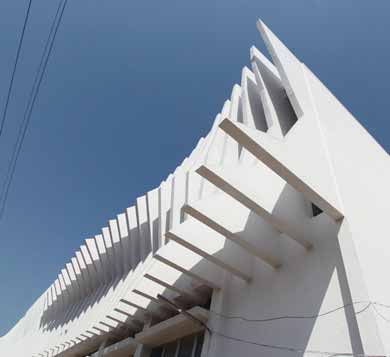
Within this context an attempt to reconstitute the functions of volume, enclosure and interfacing by means of ribd, voids, decks and varying light-conditions have been made. The vertical fin elements also act as solar shading devices particularly along the southern facade.
The sequencing of spaces withdraws the realm of familiarity and habitual patterns of behaviour that one would normally associate its inhabitants to fall into. Instead the students are confronted with an abstract composition that needs to be discovered and explored in varying degrees of space-time pedagogical related constructs. The sense of adventure, dynamism and the inherent spirit of exploration and discovery amongst children is harboured within the 'playful' and 'dynamic' striated skin of the building.
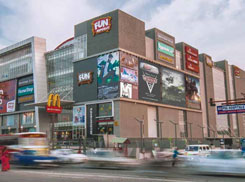
Fun Republic Mall Coimbatore
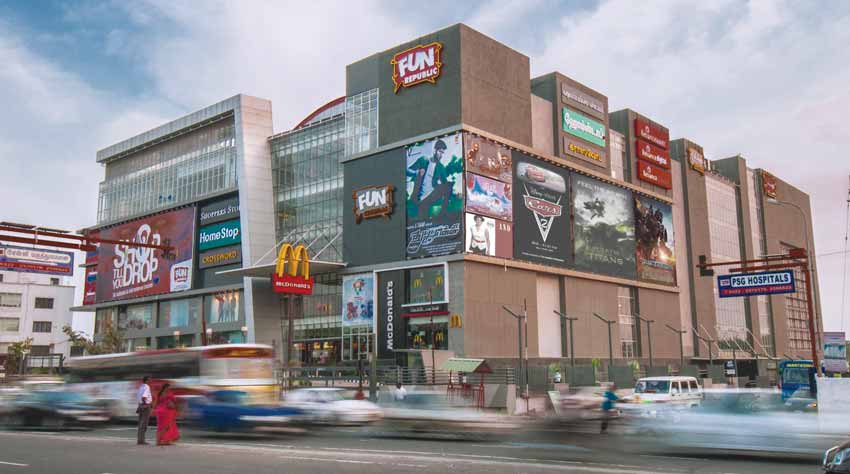
| At a Glance | |
| Project | : Fun Republic, Coimbatore |
| Client | : E-City Projects, Mumbai |
| Architect | : Arris Architects |
Project Challenge
Architecture should always draw references from its surroundings, and that we believe can be the best way to make the design more 'inclusive' rather than 'intrusive'. Coimbatore, always a flourishing town from South India, is pre-dominantly famous for textile industries. Proximity to Madurai makes it renowned for locally sourced stone. The design team was very deliberate in making material choices for the design decisions closest to the source of origin & inspiration. The opaque masses of the mall are expressed like stone boulders. Crisp massing and expression of bold lines, is the usp of design features for FR Coimbatore. But having said that, the challenges posed by tight site and its irregular depths, also had to be aesthetically addressed.The mall planning & circulation being of primary importance, an offset entrance was derived, after positioning anchors like shopper stop etc. Since the concept of vanilla shops was ever evolving, a strip of shops was arranged effectively around the anchor & its opposite sides. External entry to the anchor was denied with the intention to have free flowing footfalls in the interiors. The atrium core & vertical transit mediums are arranged around the offset entry, making the skylight highlight of the design elements. Flood of light from the skylight pours in the retail facades making them show off their merchandise against the neutral palate of mall interiors. The contrast thus achieved does not compete with the merchandise instead aids it. The visual connectivity is achieved through simple straight forward lines of sight & circulation. The mall has two cross entries aligned with the anchors, one at ground level and the other at podium level. Thus the two circulation bays are well equipped to receive the desired footfalls.
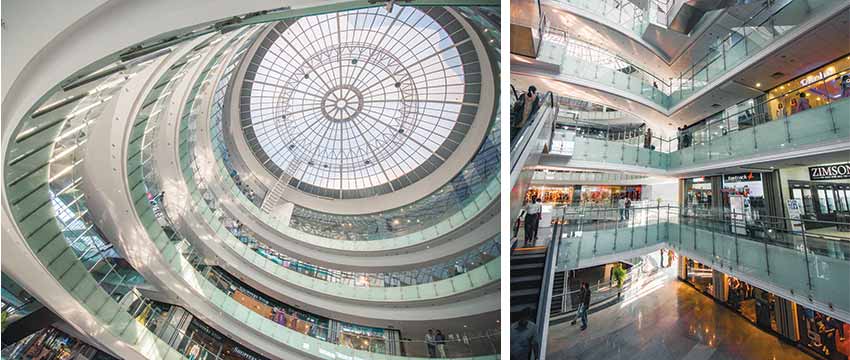
Solution
The opaque masses of the mall are expressed like stone boulders. Spaced with glass strips this got modified to painted walls due to lack of appropriate funds. Clarity of Expression is an USP for a mall to work well and that is a characteristic feature of all mall designs by Arris. Visual connectivity is achieved through simple straight forward lines of shop fronts and atrium edges. Arris has always been particular with mall economics and hence a detailed study of tenant types and their percentage of shop area were worked out, to achieve best results for the owner and the patrons, both. Their signature entrances, one at ground level and other directly at podium, both catering to anchor tenants, facilitate circulation and adequate footfalls to the mall. To avoid haphazard signanges, a central band inside the mall provides sellable signage space on all three sides.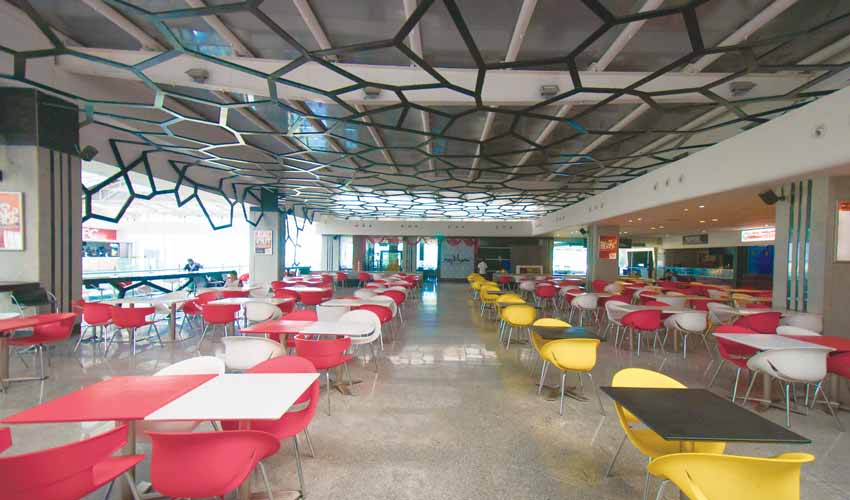
Result
The functional aspect of the mall is of utmost importance and hence the type of tenant mix, which generates and controls mall economics, is worked out and thus designed for. Then the longetivity and the performance of the mall, in terms of design & logistics, is both a researched outcome.Fun Cinemas inside Mall
Challenge

Coimbatore was one of the few properties where we had the luxury of having a good sized concession. It surrounded the central atrium of the mall and derives natural light from the same. This meant reduction on load of lighting. There were no difficulties in terms of structure of space in this property, which in fact posed as a challenge as there was no starting point. This was purely designing from scratch.
Solution
Arris Architects main inspiration was the natural light coming from dome on the atrium. They started imagining a landscape set in its natural form. A landscape with sun, clouds & trees and wanted to design something by taking elements from nature. The firm started to co-relate both experiences to each other and started working on the form.Result:
A central column is depicted as a tree with seating around it, similar traditional Chowthara around it. Tree form also resembles petals of a flower which gives it an ethnic and Indian character. Tree branches extend in the ceiling which divides the ceiling in different plateaus in stark white tone, each as if floating in midair, depicting the idea of clouds. Materials of the central tree are earthy, with browns, bronze & golden shades adding the homely feel to the form. Walls are cladded in ITA Gold stone which depict a terrain character. Leafing pattern on walls done in steel rims and mirror add glitter and life to the space.Lotus pattern of the tree radiates on the floor as well in form of inlays. Flooring of Kashmir white with black granite inlays. Tree branches come down to form entrance niches for auditoriums.

Contemporary Villa, Hyderabad
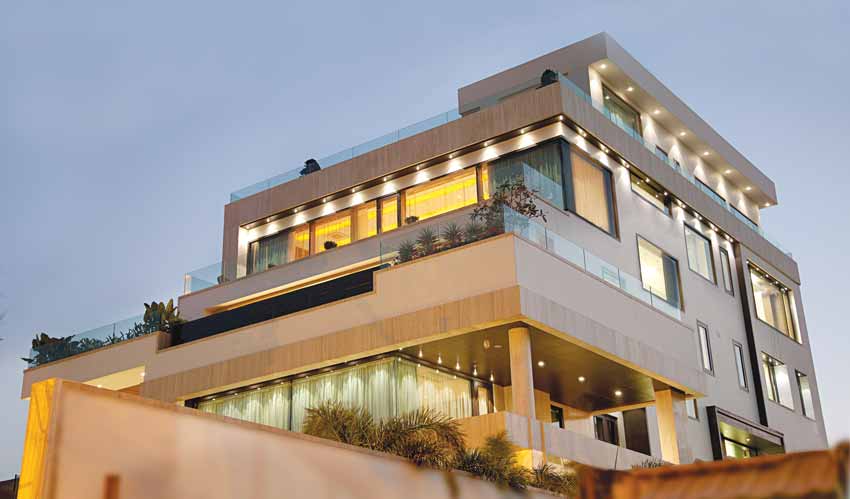
| At a Glance | |
| Project | : Contemporary Villa |
| Location | : Hyderabad, India |
| Area | : 40,000 sqft |
| Achitect | : ZZ Architects |
This 6-bedroom villa is built over 4 floors and is contemporary in style. Furniture and fittings have been sourced mainly from Europe to ensure a final project truly global and of international standards. Apart from the regular requirements in a villa, this home also has dedicated spaces such as luxurious pool deck, a games room, home spa, multipurpose gym, a lounge bar including a private area for playing cards, state of the art high end home theatre and a landscaped party terrace making this a private haven.

Design Concept
The central theme was to design a lavish home that not only relates to the physical dynamism of the space but also to mental sense of peace. The client desired a space that would reflect his sense of style with meticulous attention to detail and quality of the fit and finish. The home had to create a balance of all the vignettes in his life and assure a bespoke space for him.The strength of the architectural spaces clearly defines the interior spaces with internal courtyards, decks for bedrooms, the swimming pool with the landscaped deck that overflow the nature into the indoor spaces. At any level externally the connected feel of layered terraces receding in profile give the end user an eloquently special feel while using indoor spaces. Every architectural feature melds in to form one congruous whole while retaining its identity as a work of art.
The central theme of design of interiors was to keep the tones in white yet have a warm feel to the space. There are less objects and spaced out furniture, less contrast and a layering of textures in subtle colours.
Key Design Elements
- The main living has a 25ft high architecturally designed volumetric space that overlooks the private landscaped area. The living space also culminates as a gathering for business friends and to entertain a large number of guests. The demarcation of the layout into different seating zones for practical purposes makes it usable throughout the day. The space is magnified by the light and shadow play from the specially customized large scaled windows along the periphery.
- The infinity pool is enjoyed by all at the master level as it is overlooked from the private lounge and casual seating zones. The swimming deck exudes a youth and warm glow in the soft evening sunset.
- The design of master bedroom evokes calmness and tranquility, and showcases the personality of the end user. The master bedroom is separated from the lounge by a double height courtyard which has a water cascade that gushes through a stone clad wall giving it a sound of natural harmony. The courtyard has a skylight that filters in light into the master spaces.
- The gym and spa are located on the guest floor with a lounge dedicated to the guests. It also has an attached deck and shares the courtyard vertically with the master space.
- When the inhabitants are done enjoying the stunning skyline from the infinity pool, evenings can be whiled away in the home theatre that holds seating for 16 people. The home theatre is planned at the guest level. The meticulously planned home theatre simply takes the movie experience to another level.
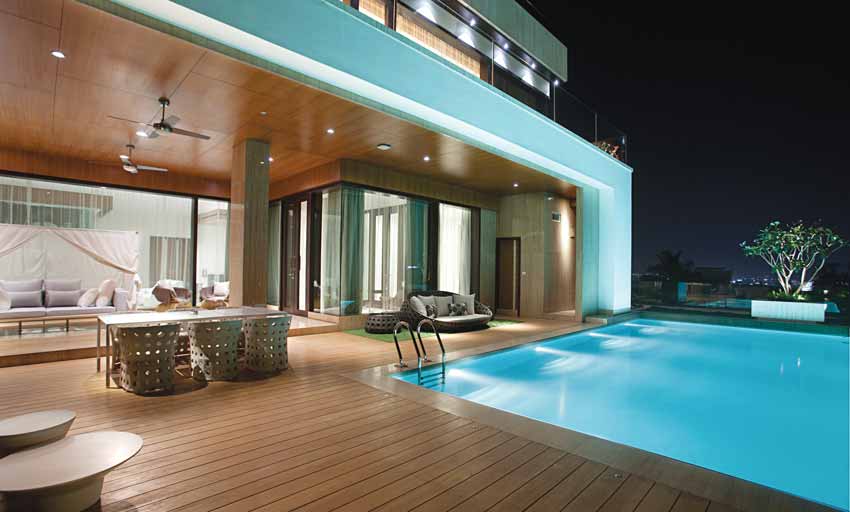
Entwined with technology and design, this villa is one of the bespoke design spaces ZZ Architects is proud to have designed.
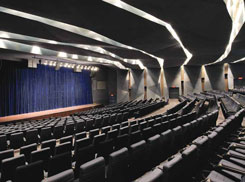
Chettinad Health City Auditorium
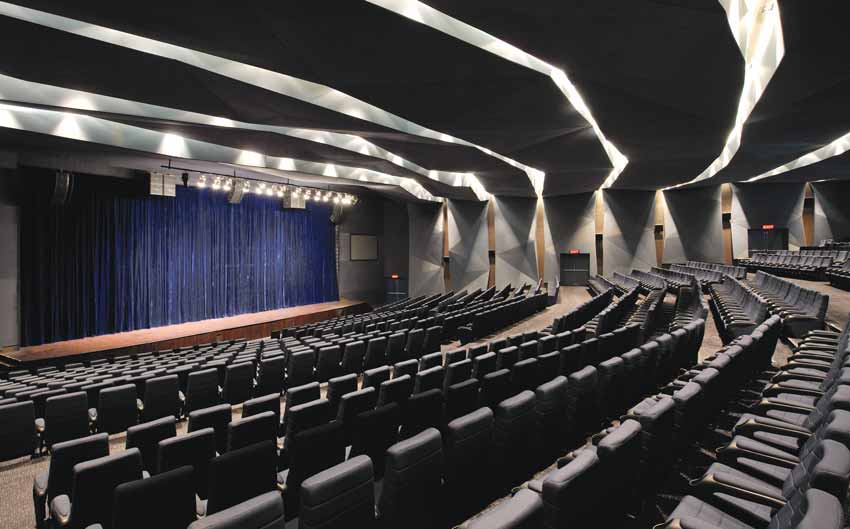
The project brief entailed the fitting-out and interiors of an auditorium facility for Chettinad Health city, to be used as part of the medical institute. The auditorium facility has been designed to cater to a diverse activities such as stage performances, lectures or seminars, projection of recorded medical information web-casts & broadcasts etc. Conventionally, auditoriums are perceived as simple, monolithic, box-like structures lined with internal acoustic paneling. The design intent was to shift away from the typical morphology in order to create a more visually dynamic space.
| At a Glance | |
| Project Name | : Chettinad Health City Auditorium |
| Location | : Chennai |
| Size | : 59,400 sq.ft |
| Design Company | : Morphogenesis |

To break away from the monotony of an unadorned environment of typical auditoriums, contemporary forms were used as insertions to create continuous surfaces which were conceived to be in the form of lines and planes that extended from the floor, to the wall and wrapped through the ceiling, thus visually connecting the three surfaces. Hence, the entire structure with the ceilings, walls and the floor of the auditorium gives a vision of being one whole surface. One enters the vast expanse of foyer spaces that are broken through geometric patterns. A similar pattern is reflected on the ceiling in multiple layers to endow the space with a sensation of enclosure and to reflect the dynamism similar to that which is shaped by the ceiling of the auditorium. The strong lines of the planes are illuminated by cove lighting and recessed light fixtures ensure that the purity of the forms and materials is accentuated, whilst enhancing visual drama within the space. The auditorium was envisaged using a similar approach, the three-dimensional geometric pattern to run through fabric-mounted, acoustical wall and ceiling panels, eventually creating a Three-dimensional envelope for the auditorium space. Wooden Slots devised as portals, were shaped as insertions within the wall to house HVAC, Lighting, audio-visual equipment and Acoustic services. To augment the randomness of the false ceiling, recesses clad in wood were used to puncture the ceiling. Materiality and palette is restrained, in order to let the continuity of the surfaces be perceived.
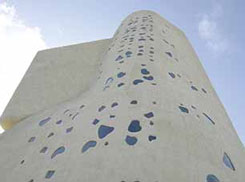
Bombay Arts Society, Mumbai, India

| At a Glance | |
| Project | : Bombay Art Society |
| Location | : Mumbai, India |
| Achitect | : Sanjay Puri Architects |
Within an extremely small plot measuring only 1300 sq. mts, a mixed use building programme based on the clients needs had to be adhered to.
Art gallery spaces, an auditorium, a cafeteria and artists rooms had to be planned within 1000 sq.mt and another 1000 sq.mt of office spaces were to be provided for, each with separate entrances.

Fluid spaces across the three lower levels, house the art gallery spaces and their allied functions with walls flowing into roofs homogenously. The fluidity of form seen externally, with a concrete skin encapsulating spaces while undulating in both the horizontal and vertical planes, is carried through to the interior volumes making the entire experience as that of moving through a sculpture.
A separate entrance lobby at the rear corner leads one up vertically into a four level office space that is angled to allow the offices unrestricted views of the ocean in the distance.
The office spaces are encapsulated in a concrete skin punctuated volume with floor to ceiling glass panels in the direction of the sea.
Thus within this small 1300 sq.mt plot two distinct set of spaces are created, each with its own discernible identity and yet enmeshed together to create a uniquely sculptural building.
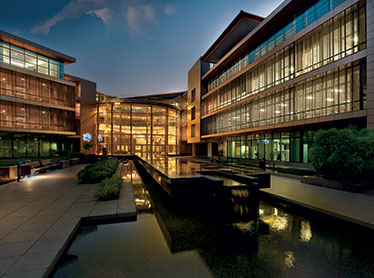
Suzlon One Earth, Pune
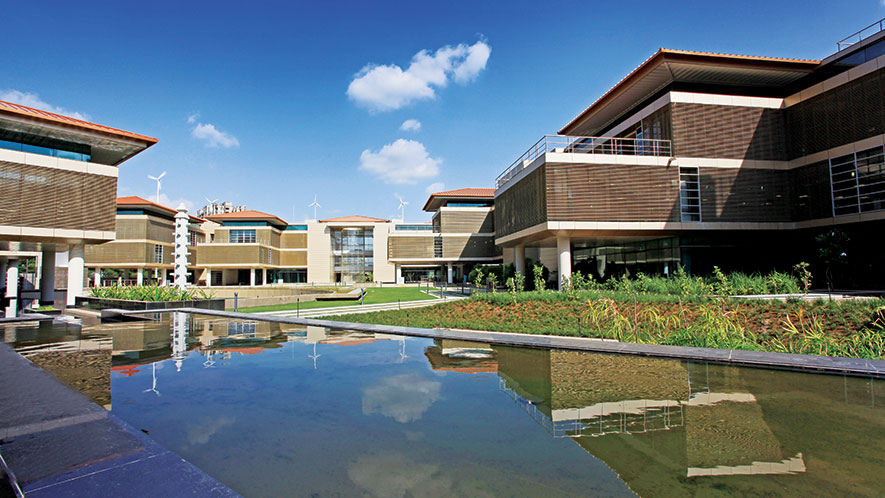
The Suzlon One Earth campus is a unique corporate headquarter spread over 10 acres of land in Hadapsar, Pune, India. The place was conceived with a business and functional need to bring all business verticals and corporate services under one roof, which although linked to each other would be independent enough to be able to perform as per their respective needs and requirements.
| At a Glance | |
| Project | : Suzlon One Earth Global Corporate Headquarters |
| Location | : Pune, Maharashtra, India |
| Site area | : 4,53,930 square feet (10.4 acre) |
| Achitect | : Prof. Christopher Benninger |

Suzlon One Earth derives its inspiration from large Indian historical campuses like Fatehpur Sikri and the Meenakshi Temple complex in Madurai. It is the need of the hour that architecture should borrow elements of critical rationalism, with over hangs, louvers, pergolas, courtyards, water and natural light permeation.
Drawing clues from vernacular architecture, while respecting nature and culture, this sustainable and efficient design provides 75% of the work stations with daylight and external views, allowing inhabitants to enjoy seasons, weather conditions and to connect with the time of the day.

The design process started with a premise of creating a central gathering space, or Brahmasthan, with the sky as its ceiling! It was conceived as a "secret internal garden" that gifts an exclusive and unique feel to the campus. There is visual access to the large central gardens from everywhere. There is a sense of connection between the various kinds of spaces right from the underground entries vide the sunlight that descends there from the Sky Courts and the Glass Cylinders and the vegetation that flows from these elements, up through the cylinders into the main circulation nodes of the building. They act as visual connectors between all floors and allow aeration of the basement parking area.
The Deepa Stambh is set in the centre of the Suzlon reflecting pool. The pool rests at the basement level, wherein all of the cafeteria and the dining room open onto the water. In the background, these see a cascade of water falls, flying down three levels of tiers, with traditional step-like objects giving rhythm to the backdrop. A long water basin feeds the water falls through a pumping system. The lineal basin links the Brahmasthal to a fountain toward the east. These auspicious components protect the campus from unwanted influences and create a central focus and landmark. They bring very Indian features within a very global, high-tech ambiance. Large water body in the central court helps in improving the air quality and for evaporative cooling. All the external landscape areas are brought into the indoors along the perimeter of the building bringing fresh air, nature and natural light into the work areas so as to improve productivity of occupants. This central garden plaza encourages communication, interaction and innovation among the 2300 colleagues and provides a stunning aesthetic presentation for visitors.
In the Wind Lounge, there is a very traditional Indian Chowk here, with kund-like steps leading into a water pool shaded by photovoltaic panels allowing filtered light in, as if through an ancient jaali.
Aluminum louvers act as a protective skin allowing daylight and cross ventilation. All areas have operable fenestration allowing natural air and ventilation when possible. These strategies resulted in lower, thinner and longer building shapes that increase the ratio of fenestration to volume, enhancing natural light and ventilation in a hot and dry climatic conditions.
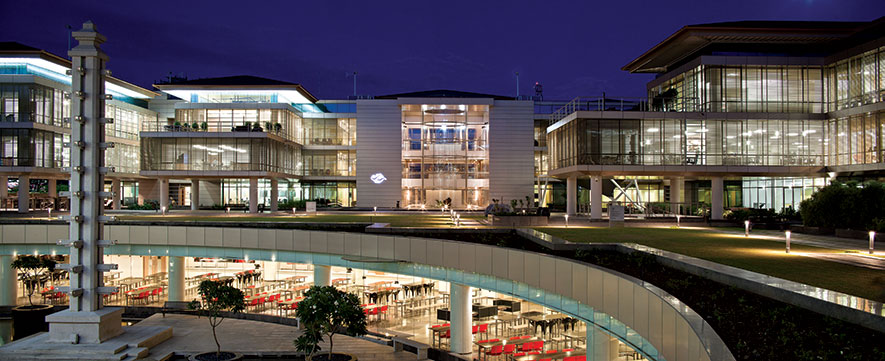
The building employs a complex building management systems. Lighting of individual offices is controlled by combined daylight and occupancy sensors. Sixty five percent of energy is saved by use of LED outdoor light systems in comparison to conventional scheme. Thirty to 40% reduction in operating cost, due to energy savings and water savings at 30%.

The Goa Institute of Management
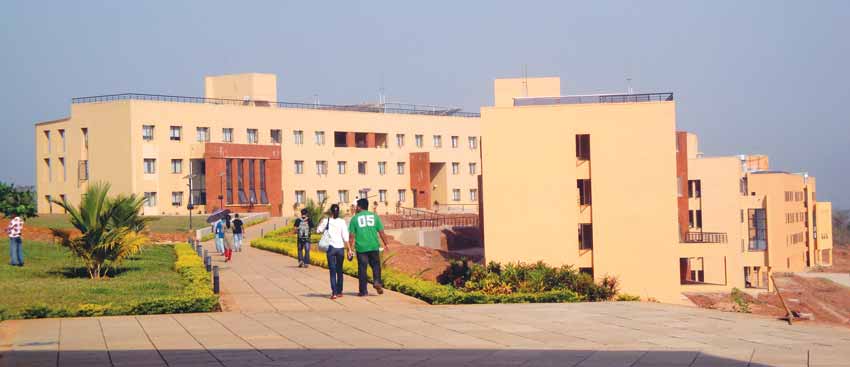
The Goa Institute of Management (GIM) was conceived as a 'state of the art' facility for Management students. The site is a 50 acre contoured plot surrounded by undulating hills and valley views.

The clusters of built forms on the site respond to the organisation in the Masterplan and the lay of the land. The buildings are contemporary structures that are detailed with fenestrations and punctures that frame vistas. The complex was planned along two axes pointing to the cardinal directions at the crossing which is located in the main academic block. The central plaza within this block leads to the Library and cafe in the west, the hostels in the north and the multi-purpose hall in the east. The faculty housing is located to the north of the multi-purpose hall on a hillock.
| At a Glance | |
| Project | : Goa Institute of Management |
| Location | : Goa, India |
| Achitect | : Somaya and Kalappa Consultants |
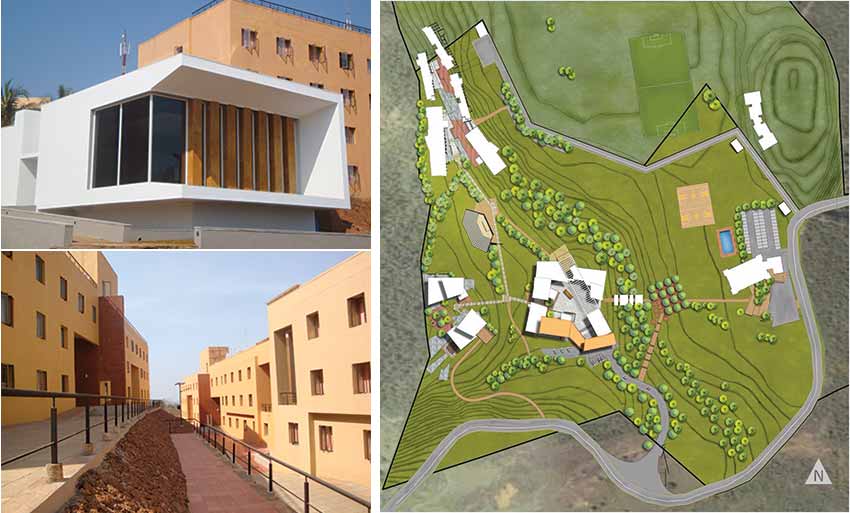
Differences of levels and changes in textures distinguish spaces, while vertical planes with voids define them. The individual buildings have been designed with cavity walls and deep overhangs to reduce the heat gain and also provide protection during the heavy monsoon. Laterite, the naturally occurring stone in this region and abundant on the site itself, was used extensively as wall fillers, soling and cladding.
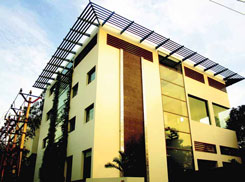
Global Design Studio of Shilpa Architects
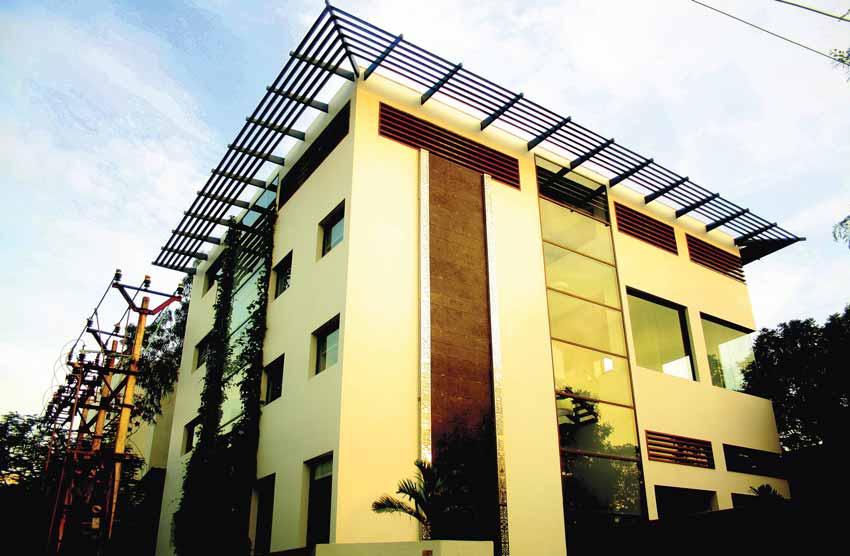
The Global Design Studio of Shilpa Architects Planners Designers was awarded the Leadership in Energy and Environmental Design (LEED) Platinum rating for New Construction by the Indian Green Building Council (IGBC). The LEED Platinum certification is an endorsement of SHILPA's design philosophies, and corporate responsibility goals. The eco-friendly office space includes benefits such as lower operating costs and a reduced carbon footprint.
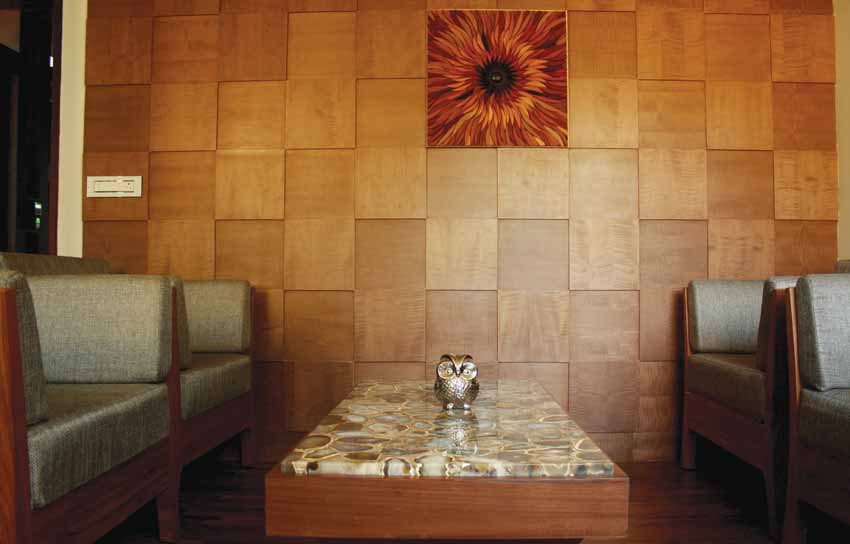
| At a Glance | |
| Project | : Global Design Studio |
| Location | : Chennai, India |
| Achitect | : Shilpa Architects Planners Desginers |
The building is split into multiple levels of studio space and a level each for client/vendor interaction and a Gallery. Conference rooms and open spaces are designed for initiatives to educate students, the general community and promote art. The staggering of floors gives the office spatial and visual connectivity. Vertical ducts rise in the "green shafts" through which the conditioned air is circulated into the work and interaction spaces. The building is a single volute with the staggered levels directing the circulating air through the entire building, till it is mechanically vented out at the top of the staircase headroom. The efficiency of the Air Conditioning System is enhanced by the heat recovery wheel. Carbon-di-oxide build up is minimized because most of the air is exhausted back to the ambient. Radiant slab and Geo thermal cooling are incorporated in the HVAC System design to reduce power and water consumption. Solar power generation and use of RO treated ground water for Air Conditioning are special features of the building's engineering.

"A green building is one which uses less water, optimizes energy efficiency, conserves natural resources, generates less waste and provides healthier spaces for occupants, as compared to a conventional building." (www.igbc.in/)
The Leadership in Energy and Environmental Design (LEED) Green Building Rating System is a nationally and internationally accepted benchmark for the design, construction and operation of high performance green buildings.
Entrance & Reception Lobby
The entrance to the building is marked by a tribute to a Hindu deity, "Vishvakarma", considered to be the divine ARCHITECT! The sculpture is hand crafted specially by artisans from the Bhavani district of Tamil Nadu. In order to add local artisan touch as well, the modern "Mandap" was crafted in Mahabalipuram.Continuing with the idea of the "Temple of Design", the grand door is inspired by traditional temple paneled door. With antique brass detailing, the door stands a majestic 12 feet in height and has to be opened by each and every visitor in order to experience the feeling of having entered the space.
Upon entry, one steps into the "Akhand" which is inspired by continuity through the same treatment for the floor, ceiling and walls thereby living up to its Sanskrit meaning - UNBROKEN! Treated with the most basic building block of Architecture, the space is built using country brick bonding technique.

The double height reception connects to the above workspaces both visually and aurally. The reception itself is treated with simple rustic material and one gets the first glimpse of exposed concrete ceilings.
The character-building element that is interpreted throughout the spaces in varying forms, scale and composition, is the company logo inspired trellis detail.
Client interaction spaces
The client interaction areas at the Global design studio have been designed for various types of meetings and discussions.The conference room is styled like a functional space addressing the need for large format design meetings.
The boardroom is designed as a double height formal space with maximum views and day lighting to provide an outdoor like meeting setting. The extensive use of fabric and eclectic collection of artifacts brings warmth to the space.
The lounge has been designed with natural quartz (agate) and wood accents. With the unique hand crafted light box, this space highlights the usage of fabric in innovative and exciting ways.
The touch and feel library is a unique client interaction area that helps envisage projects along with material samples and mood boards.
Other Workspace and Building Features
- 1st time prototype of pioneering energy & resource efficient AC system
- 6% generation of power from photo-voltaic panels
- 8% lower overall construction cost
- 30% energy & water savings monthly!
- 30% higher levels of indoor air quality to promote workplace productivity
- 95% of office space with natural daylight until sundown
- 100% waste recycling at source.
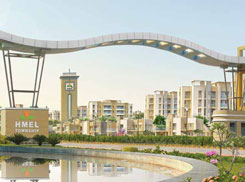
HMEL Township, Bathinda, Punjab
| At a Glance | |
| Project | : HMEL Township |
| Location | : Bathinda, Punjab, India |
| Achitect | : Architect Prem Nath & Associates |
Concept
The project – HP Mittal Energy Limited (HMEL) township was conceptualized, to be, one of the, most simplistic in design, yet interestingly garnished with green & eco-smart features and topped with lush Landscaped acres. Citizens residing in the complex are from various financial strata and status – yet sharing common utilities like the Club House, Pool, Gym, Amphi -Theaters, Shopping, etc.A Gated Community living at a Locale far from the city; Secured Living without any fencing, compound wall or any other barrier (physical & physiological) between each house – all homes are simply segregated with Green Hedges.

Planning
Planning concept for the project had been kept simple and practical. From the entry to the end the property is Curvy-linearly divided by the Main road in east-west direction. On the Southern Side, of this road, Individual Villas are planned and on the Northern side the Apartment buildings – enabling a comfortable and homogeneous combination of different strata personnel.The main road shall act as the 'Back Bone' to the project, wherein all main services, vehicular traffic, pick-up / drop-off points, etc. shall run. This 24 M wide road, is also provided with a parallel service road (on one side) of 8 M width, for Phase-1 area. All other areas are well connected with 8 M wide roads, and 2 M paved service sub-passage on either sides with Green Cover. Along side the main road – at the entrance are the admin building, auditorium and the medical center, while the inner areas have been planned with amphitheater, market place, club, etc.

Two Helipads have been planned at Northern corner of the plot, which is connected to the external village road, for direct entry exit. Future development too has been planned keeping in mind – separate entry requirements during construction – through the side village road. Interesting factor in the township shall be its strategically placed landscape islands interlaced between the villas and apartments.
The entire Master Plan is planned with ample green spaces, and shall be cultivated with mostly local trees and plantations. The green cover in ranges to about 540,000 Sft. of land area, clad with lawns, bushes, shrubs, hedges, and variety of trees, etc. The entire periphery of the land mass has been bordered with couple of variety of Neem trees – these trees shall not only provide visual privacy, but shall also cut-off the noise and air pollution, especially towards the main approach road. The Main Road, has been edged with flowering trees (at the entrance side) like 'Gulmohur' and trees like 'Silver Oak', 'Ashok Pendula', 'Alostonia Scholraris', etc. – these shall again provide a great green ambience. Internal green spaces (larger ones), too, have been studded with these trees. The Ground Cover plantations like 'Golden Duranta' have been used for road dividers, etc., while shrubs like 'Aschilfa Godesfina' and 'Ficasa Panda', shall be laid in and around the villas' and apartments' green spaces. Apart from the above, two types of lawns are planted, i.e. 'Organized Green Lawns' and 'Informal Green Areas'. The Garden spaces between the cluster of buildings are provided with garden furniture, paved jogging track, children play equipments, and other child centric amenities. Lawns, Gardens, walkways have been well lit thru garden bollards and street lights. All Roads and Driveways shall be Paved – while the Main & Internal Roads shall be paved with Paver Blocks, the Drive ways and Parking areas shall be laid with Paver Tiles.

Green Features
Being Awarded GOLD Grading by the MoEF – itself is the Testimony of the Township's Green Excellence. The project was added with a lot of value addition in terms of its eco-friendly features which are listed below:Rain Water Harvesting: An efficient way of collecting, renewing and reusing an important natural resource like Water; The township has been planned as a 'Zero Depletion' site, with all rain water being collected and recharged back to Mother Earth, thru strategically placed percolation pits; also the extent of the green areas on the site with itself allows all the rainwater into the soil to fill up underground water tables.
Sewage Treatment Plant: All waste is being treated in STP, converting the sewage into reusable water for landscape and makeup water for the HVAC systems of public areas. This system was further be topped with Bio-degradation system for solid waste – which in-turn provides Cooking Gas, for the Club House.
Solar Water Heaters: This is a tried and tested system, being used widely by residential townships – each villas, apartment is having a small installation on the roof-top, which shall suffice the daily Hot Water requirement, with most minimal or zero power consumption, for the same.
Insulated Walls & Ceiling: Use of Fly-Ash-Cement Blocks for external wall construction can enable temperate difference of atleast 4*C to 6*C between exteriors and interiors – the site being in the one of the extreme climatic conditions – the said system helps not only during hot summers, but also during cold winters; Similarly Brick Bat Coba, efficiently laid over the top roof of buildings provides heat insulation from top – this system again adds to the temperate difference.
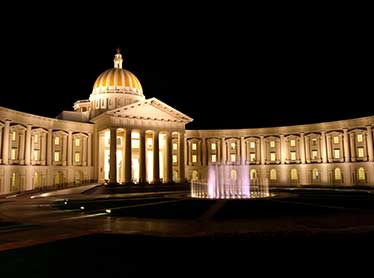
Global Education Centre

| At a Glance | |
| Project | : Global Education Centre |
| Location | : Mysore, India |
| Area | : 337 acre |
| Achitect | : Ar. Hafeez Contractor |
Given its infrastructure and size of operations, Infosys' GEC is the largest corporate education centre in the world. Set on a sprawling 337-acre campus, Infosys' educational and training hub has the capacity to train over 14,000 people at the same time. It is, in essence, an inception centre to thousands of Infosians who hail from all walks of life, diverse nationalities and cultures. The architectural language for the GEC building was derived from an appreciation of classical tradition in architecture and arts. Its classical style is the culmination of the highest refinement of construction and it speaks of stability, longevity and strength – all the qualities that are the institution's core principles.

The imposing structure with lofty domes, tall pillars and spacious interiors brings to mind the grand Mysore palace with its dramatic three-storied stone structure made with fine granite and set amidst meticulously trimmed gardens with a profusion of delicately curved arches, bow-like canopies, magnificent bay windows and columns in varied styles. A large central courtyard formed by the curvilinear building wings marks the approach to the central entrance porch of GEC – II.

In terms of aesthetics the entrance porch is flanked by six Doric columns with a pediment raised by a high plinth. These main columns in the denticular Doric style have been designed and built according to the principle applied in the Doric orders of Vignola. Each column is 56-feet in height and 7-feet in diameter. There are 86 smaller Doric columns along the entire façade set above a solid ground-floor base. A central dome that holds the entire structure together is the most stunning feature of the building. It measures 65-feet in diameter with its pinnacle rising 195 feet above the ground.
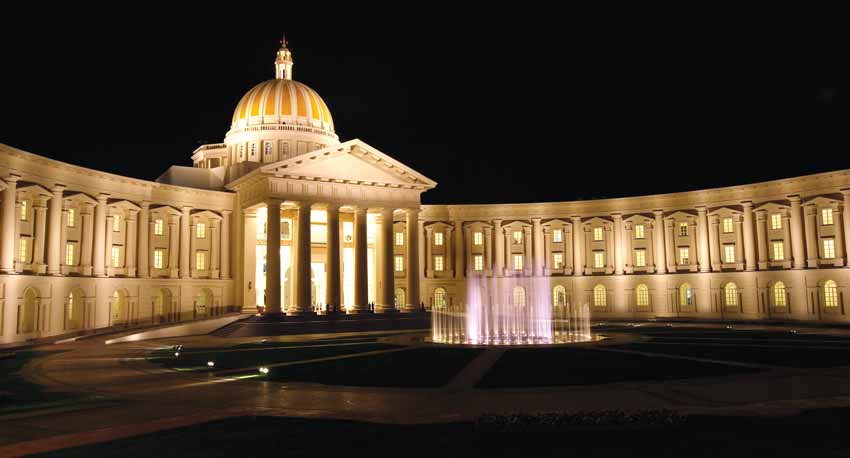
The qualitative aspect pronounced by classical forms allows the transition of experiential spaces that is required for this institution. The entrance porch leads to two central spaces; one is circular and the other is an elliptical naturally lit space that gives the structure ample scope to conceal and reveal effects. This two-storey structure is set on a slope and includes two lower-ground areas that are connected to neighbouring blocks. The third-floor houses a library around the elliptical skylight. It measures 40,000 sq ft and is surrounded by terraces overlooking the ground floor lobby. A large, impressive meeting hall beneath the dome accommodates around 40 people and has a separate waiting lobby accessible from the library level. The lower ground-floor includes the concept centre with online classrooms, examination halls and other management and administration rooms surrounding it.
The facility boasts of several classrooms that can accommodate 100 people each and few halls that can hold up to 200 people each. There is a food-court that seats 1,550 people indoors and 250 people outdoors. Its stair court is a triple-height space architecturally treated with columns and arches with cast-iron railings at intervals. All in all, it's a grand concept that encourages visionary thinking brought together by a world-class company.
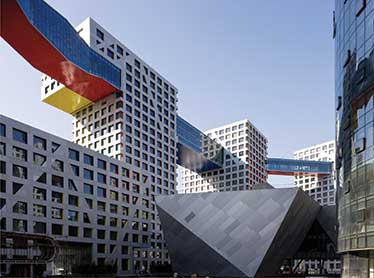
Linked Hybrid - An Open City Within A City

"The council of Tall Buildings and Urban Habitat (CTBUH) has recently awarded the Steven Holl Architects' Linked Hybrid Complex in Beijing as the 'CTBUH 2009 Best Tall Building Overall' selecting it from among various candidates from regions worldwide.
The CTBUH recognizes one outstanding tall building from each of four geographical regions: Americas, Asia and Australia, Europe, and Middle East and Africa annually. Recipients must possess seamless integration of architectural form, structure, and building systems, as well as exhibit sustainable design qualities working to preserve the quality of urban life and this year the honor goes to Steven Holl Architects' for their superb design of "Linked Hybrid Complex" in Beijing.
Commenting on the project during an award ceremony, CTBUH Awards Committee Chairman Mr. Gordon Gill stated, "This project is very rich in thought, both programmatically and architecturally. It presents an advances typology for dense urban living," whereas CTBUH Executive Director Antony Wood said, "This project 'Linked Hybrid' points the way forward for the intensified multi-use, multi-level connected cities of the future."
Project Description

The 220,000 square-meter Linked Hybrid complex in Beijing, aims to counter the current urban developments in China by creating a twenty-first century porous urban space, inviting and open to the public from every side. A filmic urban experience of space; around, over and through multifaceted spatial layers, as well as the many passages through the project, makes the Linked Hybrid an "open city within a city." The project promotes interactive relations and encourages encounters in the public spaces that vary from commercial, residential, and educational to recreational; a three-dimensional public urban space.


| Location | : Beijing, China |
| Architect | : Steven Holl Architects |
| Client | : Modern Group |
| Floor area (square) | : 2383797sf/221462sm |
| Floor area (square) above | : 1753775sf/162931sm |
| Floor area (square) below | : 629635sf/58495sm |
| Building area (square) | : 2368060sf/220000sm |
| Status | : Completed |
| Structural Engineer | : Guy Nordenson and Associates: Derek Chan, Erik Nelson, Guy Nordenson, Claire Argow |
| Associate Structural Engineer | : Capital Engineering and China Academy of Building Research: Xiao Congzhen |
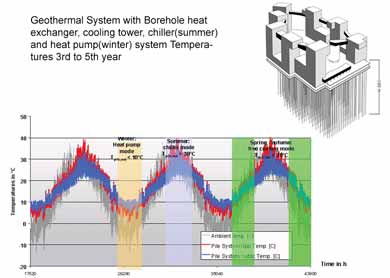
All public functions on the ground level - including a restaurant, hotel, Montessori school, kindergarten, and cinema - have connections with the green spaces surrounding and penetrating the project. Elevators displace like a "jump cut" to another series of passages on higher levels. From the 18th floor a multi-functional series of skybridges with a swimming pool, a fitness room, a café, a gallery, etc., connects the eight residential towers and the hotel tower, and offers views over the unfolding city. Programmatically, this loop aspires to be semi-lattice-like rather than simplistically linear. Hope the public sky-loop and the base-loop will constantly generate random relationships; functioning as social condensers in a special experience of city life to both residents and visitors.
Focused on the experience of passage of the body through space, the towers are organized to take movement, timing and sequence into consideration. The point of view changes with a slight ramp up, a slow right turn. The encircled towers express a collective aspiration; rather than towers as isolated objects or private islands in an increasingly privatized city, the hope is for new "Z" dimension urban sectors that aspire to individuation in urban living while shaping public space.

Geo-thermal wells [660 at 100 meters deep] provide Linked Hybrid with cooling in summer and heating in winter, and make Linked Hybrid one of the largest green residential projects. The large urban space in the center of the project is activated by a greywater recycling pond with water lilies and grasses in which the cinematheque and the hotel appear to float. During winters the pool freezes to become an ice-skating rink. The cinematheque is not only a gathering venue but also a visual focus to the area. The cinematheque architecture floats on its reflection in the shallow pond, and projections on its facades indicate films playing within. The first floor of the building, with views over the landscape, is left open to the community. The polychrome of Chinese Buddhist architecture inspires a chromatic dimension. The undersides of the bridges and cantilevered portions are colored membranes that glow with projected nightlight and the window jambs have been colored by chance operations based on the 'Book of Changes' with colors found in ancient temples.
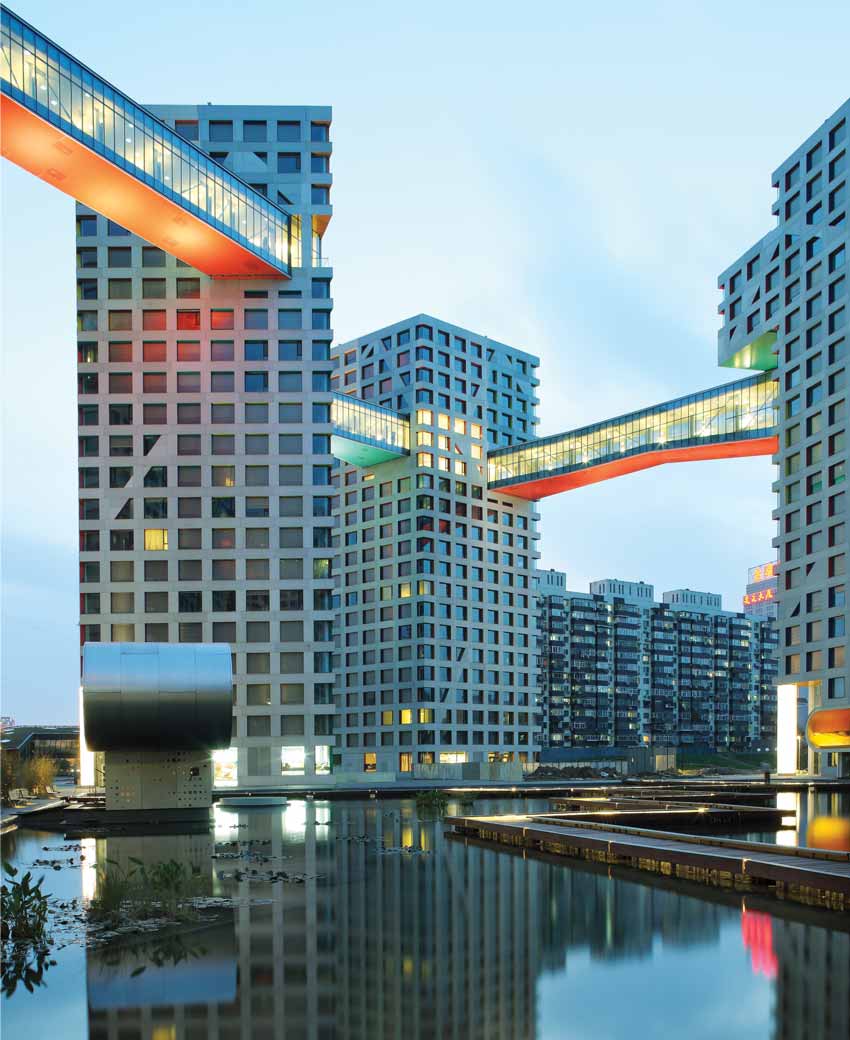
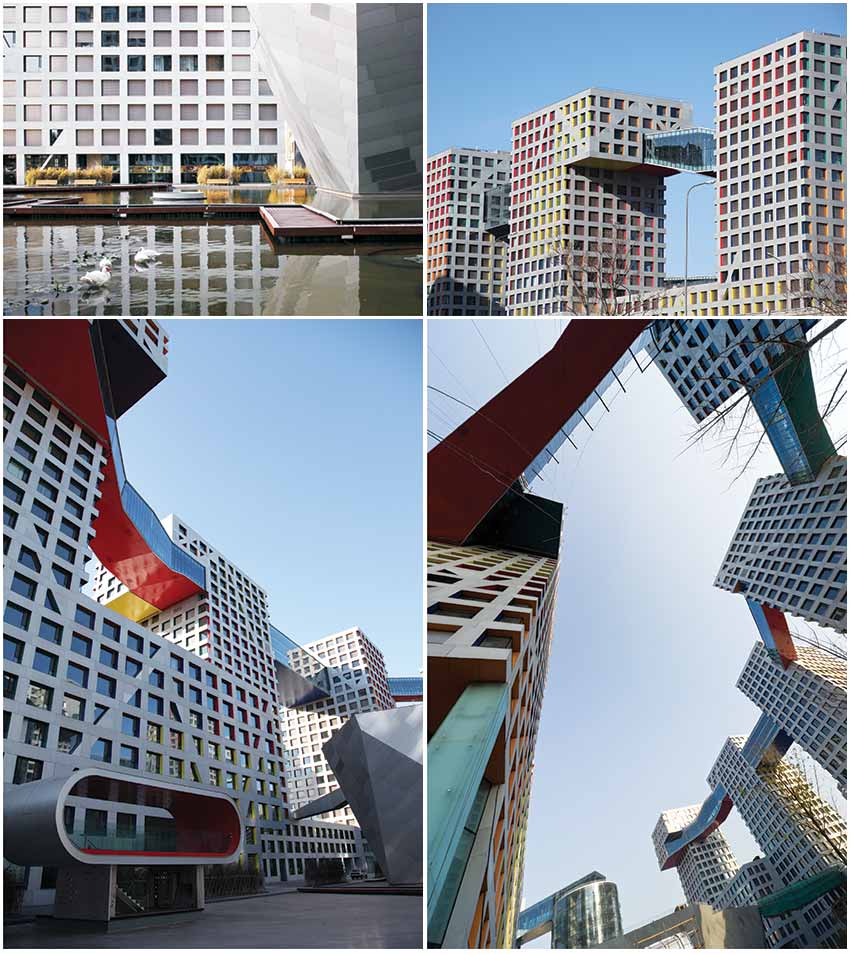
Towers
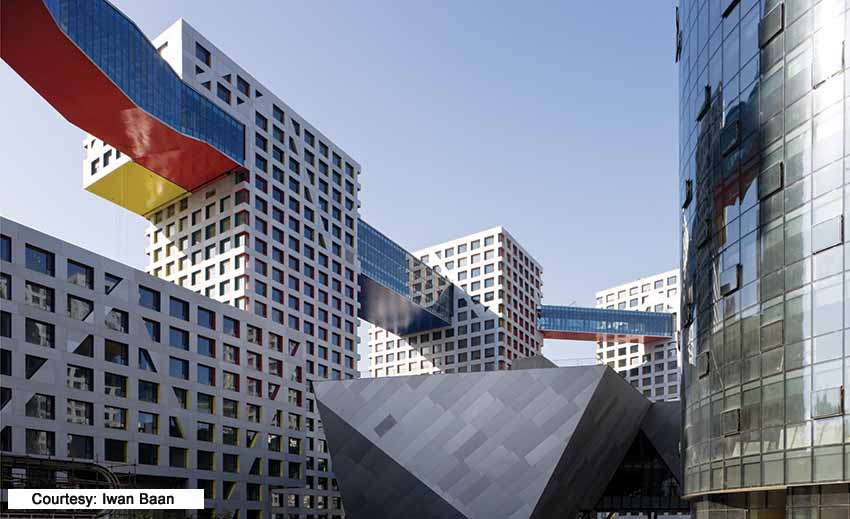
The project is a housing development for 622 apartments and a small hotel in eight interconnected towers. The towers are about 30m by 30m in plan with concrete flat slabs spanning between core and cross concrete shear walls and a perimeter concrete moment frame. The frame is a grid of uniform dimension interspersed with diagonal members. These diagonals occur on an adhoc basis where required for building cantilevers, overhangs and overall stiffness. Taking into consideration the substantial seismic demands of Beijing and the stringent code requirement of torsion, GNA undertook a number of design challenges: the core and cross concrete shear walls were used around the elevator shafts to provide a gravity load path for the long span flat plates and also substantial stiffness and resistance to seismic activity. Each of the seven bridges is isolated from the towers to minimize transfer from the bridge to the building tower.
The weight of the large cantilevers at the upper levels was decreased by using steel and concrete composite framing to cut down the self-weight. Lastly, systematic bracing members were added around the perimeter of the towers to increase torsional rigidity.
Bridges
The goal of the bridge structural design was to maximize transparency and create floating hallways of light, traversing 30 to 40 meters between the heavy concrete towers. In order to span the great distance required and also to achieve the utmost transparency, the bridges utilize a pair of parallel steel trusses (the truss being the most efficient form to resist flexure). A Pratt truss configuration was chosen to use thin tension only diagonal members and, in order to make the truss more elegant, the angle of the diagonals is variel, achieving a truss form with members oriented in such a fashion that the sizes of the diagonals have equal stresses, hence equal sizes. The connections between vertical and horizontal truss members were made rigid to form a complete three-dimensional rigid Vierendeel frame. This provides additional stiffness and redundancy to the bridge structure and allows for the removal of the center panel diagonal members.Bridge Isolators

The bridges are light and glass enclosed. In order to protect them from the effects of significant tower movement under an extreme seismic event, it was decided to isolate both sides of the bridges. The system selected was a "friction pendulum isolator" which is provided by Earthquake Protection Systems of California. The isolators are shaped with a radius to achieve a described period of vibration that will minimize the shear transfer by reducing the resonance. In an earthquake, the bridges will move up to 40cm relative to the buildings, sparing them, and the buildings, of the effects of lateral forces.

Everingham Rotating House Australia
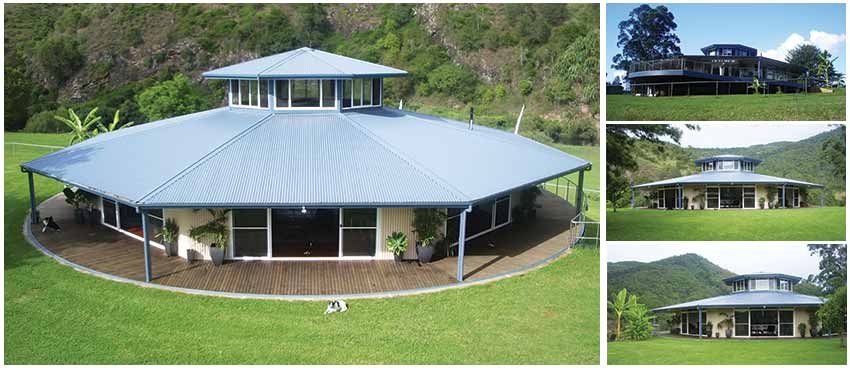
An Australian couple Everinghams dreamt to make a house a decade ago that can allow the user to match the orientation of the home to the daily weather patterns. And today their imagination has taken a shape of reality in the form of Everingham Rotating house that can rotate up to 360 degree if and when desired within a 180 degree retainer wall and a 180 degrees fixed deck and railing. The couple feel that they are on the eleventh clouds as their dream comes true.
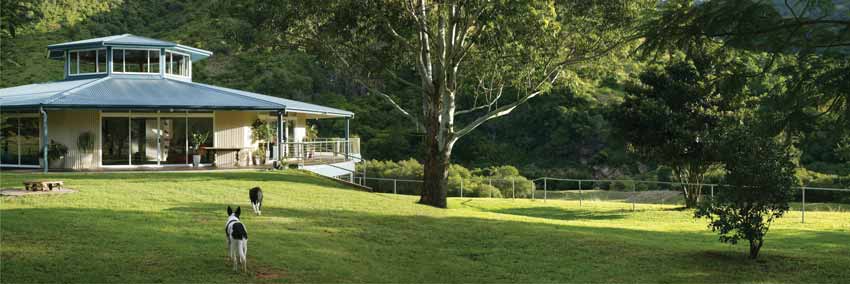
The Everinghams have been in a spin since they moved into their dream home in the countryside north of Sydney three years ago. They can turn the house to follow the sun without having to leave the comfort of their armchairs. "When you wake up you do wonder where you'll be facing," said Luke Everingham, a sound-engineer who came up with an idea of a rotating house with his wife, Deb.
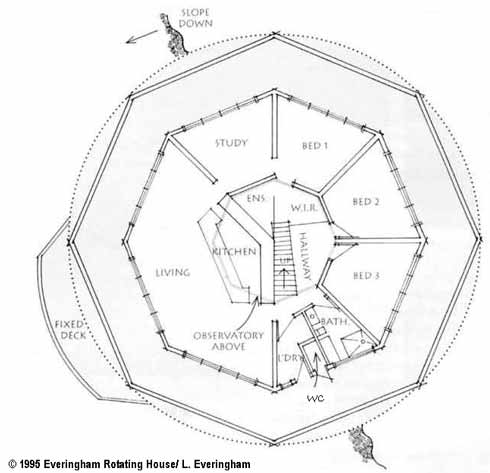
Concept of the project
The rotating house guarantees a different view every time you wake up. The concept for this project is the result of nearly a decade of intermittent research, planning and design, and ten months of construction over a two year period consuming all disposable time. The project was completed in March 2006.As per the owner and designer of the house Mr. Everingham, "The idea was born when our neighbors were expounding the virtues of their new home and commented that if they could start again they would orientate the house 15 degrees more to the north. To this, Deb his wife said "Wouldn't it be handy to have a house that could move?"

Immediately Mr. Everingham started thinking the features which could lead the house to move. Certainly several points come in his mind as Weight? The average house would weigh approximately 20-30 tons or about 1 ton per square. Weight is not difficult - ancient mechanical and structural engineering, he commented. What about Shape? The conventional rectangular prism would not be suitable, he pointed. After experimenting with scale drawings to investigate octagonal and circular shapes, he was pleasantly surprised as a number of preliminary designs and layouts were created.
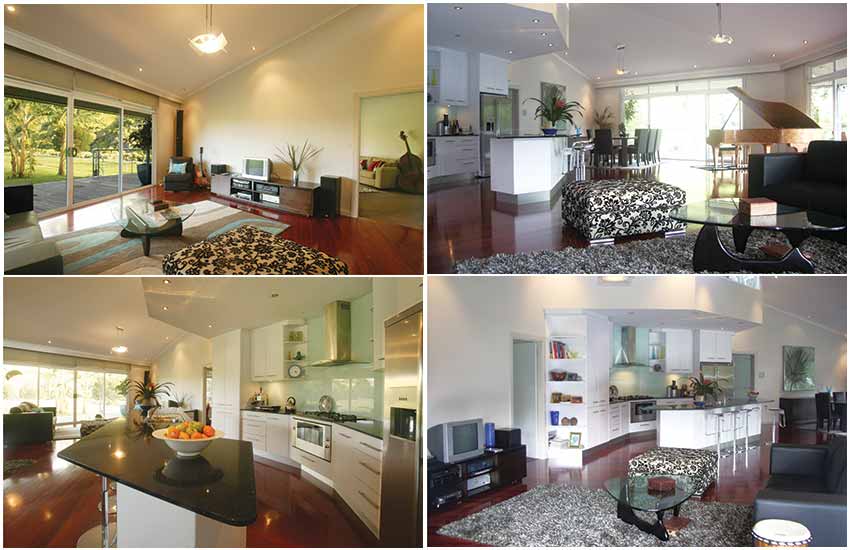
Elaborating on his points he said "At this stage we sat on it for many years on the assumption that the cost would be prohibitive. In mid 2002, we decided that our 87-year-old white ant-ravaged farm house was beyond renovation and hence we started looking for new house options. We were somewhat shocked at the cost and how mundane the end result would be compared to our "Everingham Rotating House" design.
In January 2003, research into the cost of the project commenced, and 6 weeks later we came up with an estimation that it would not cost any more to construct than a conventional house of a similar size and level of appointment.
The construction of the house would not have been possible without the assistance of the Coastline Credit Union in Taree. The standard banks did not have the appropriate computer pigeon holes to cater for our particular circumstances. The Credit Union was prepared to consider our application on its own merits. By December 2003 we had organized finance and construction certificates and building commenced!
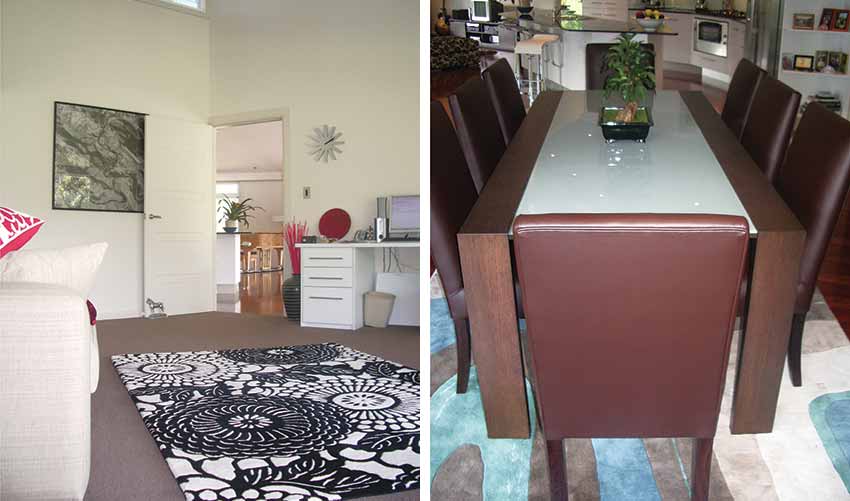
Design concept
The entire design concept has been firmly based on the following principles:- The cost must not exceed that of a conventional house of the same size and level of appointment;
- The layout and finish must be highly functional;
- The end result must require very little maintenance;
- The house must be white ant proof;
- The rotating aspect must allow the occupants to maximize exploitation of weather conditions, seasonal conditions and outstanding 360-degree views.
Features of the house
The Everingham rotating house is a 24-metre diameter octagon and this octagonal nature of the house allows for irregular-shaped rooms with a lot more space than most conventional houses. Windows and glass doors constitute a large part of the exterior walls, in order to take advantage of both the views and the warmth of the sun. The wraparound verandah is a 3 meters wide hardwood timber deck.The entire structure, weighing approximately 50 tons, rotates up to 360-degrees if and when desired, within a 180 degree retainer wall and a 180 degree fixed deck and railing. The house can be set up to follow the sun or to avoid the sun. It can be moved to get out of the wind or to catch the breeze. The house is relatively cheap to build due to the simple design of the electrics and plumbing and the simple nature of the rotation device which controls the rotation by using a touch panel on the wall of the living room which can be pre-programmed or operated manually." Some other features of this house are listed below:
- The exterior walls: vertical corrugated COLORBOND®
- The interior walls: predominantly Gyprock
- The mechanics: 200-ton central bearing, 32 outrigger wheels and two 500-watt electric motors attached to reduction gearboxes and drive-wheels.
- Insulation: CSR Bradford 2.5 Anticon roof insulation, all internal and external walls use the R32 sound screen wall batts and 100ml thick ceiling batts throughout the ceiling.
- Geothermal piping 120 meters long and 2.5 meters deep supplies a constant 22oc to the house through the central core.
- Roofing: COLORBOND®
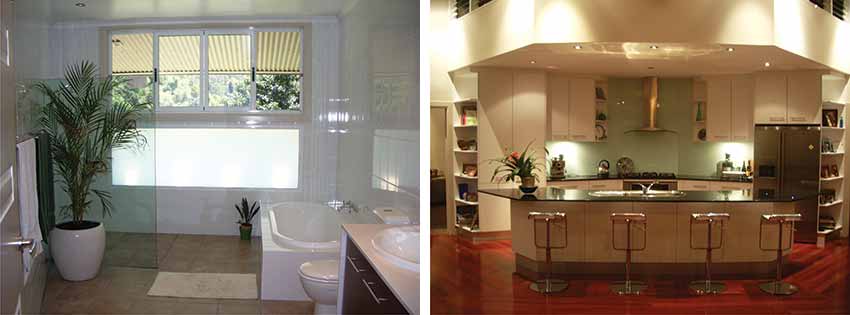
The house cost about $1900 a square meter to build and can complete a full rotation in about 30 minutes, according to Everinghams. The family is now in the business of exporting the Everingham Rotating House (ERH) around the world. Each ERH can be customized to meet the requirements of each unique application (i.e. Larger or smaller diameter, more or less bedrooms, utilization under house area for storage or garage etc, an internal garage, second story, second story verandah 360 degrees etc). These designs are directed at the domestic and commercial markets. In addition, there are many environmental options available. They have further researched to make this already environmentally friendly house... friendlier.
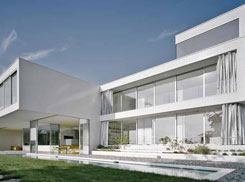
Georg Spreng’s House Is More Than a House

Everyone desires to make their house a home and do best to make their dream project a reality. An industrial designer Georg Spreng, also the founder of group Frogdesign has spent many years of his life living in Canada, and the experiences he made there were very important to him. In Canada Georg Spreng had lived on an estate which was so large one could loose ones way on it. Living in a house, he experienced that different weather – proved how vulnerable humans are and how strong nature can be. From these experiences, he developed an intense connection to nature. This is why – with his own house - it was important for him to build up a connection to the landscape and to let the house step in to the background. He wishes to bring a sense of the expansive open spaces back to his homeland in Wissgoldingen, Germany also. Spreng's idea was to combine work and living in one building; but he also wanted that each have their own separate areas. If at one side he needs the house to be connected with the landscape then at the other side being a design professional, he is interested in materials combination and how people react to them and handle them.
| Project | : Residential House with Jewellery Studio |
| Location | : Wissgoldingen, Southern Germany, near Stuttgart |
| Architects | : C18 Architects, Stuttgart |
| Date of completion | : May 2008 |
| Gross floor area | : 615 m² |
| Gross volume | : 2.049 m³ |
| Photographer | : Miss Brigida Gonzalez (www.brigidagonzalez.de) |
| Client | : Georg Spreng |
With all these in mind, Spreng approach to the German based architectural firm C18 architects and has a detail dialogue with the architects. The dialogue between the two lead to unusual material combination, to combination which doesn't follow established conventions. Materials should be allowed to speak, be allowed to appeal to sense and feelings. The location Spreng selected is the Swabian Alb, a low mountain range in Baden-Württemberg, Germany, fascinated by breathtaking landscapes, vast views, jagged cliffs and large caves belonging to widely branches out underground system.

After visiting the site of construction, C18 Architects developed a layout which accomplishes well all desired features. Designed by Marcus Kaestle, Andreas Ocker and Michel Roeder of C18 Architects the two level structures contain a house and a Jewellery studio.

Structural Design
Towards the street the building is closed; it attracts attention with its cladding of white square tiles. The buildings cubic shape also distinguishes it from its neighbors. Even if the house is closed towards the street, it doesn't close itself to the neighbors. A tower room with a window facing the street positions the building in the neighborhood. No fence hinders visitors from entering the premises and looking over a wall onto a pond in an open atrium and into the living area. At this point two entrances lay symmetrically to each side. They both have red emergency shutdown buttons as bell buttons. From this standing point one can already notice a considerable lot about this house; the way it entangles inside and outside and that it is a special house.Two levels lay over one another like two U-shaped brackets. The upper bracket is open towards the street; the lower bracket is open towards the countryside. Through the resulting eyelet one can look down from the entrance area onto a pond in which lays a small island upon which a tree was planted. The tip of this tree can be seen from the upper level from the street. The lower bracket has shorter sides than the upper one so that the upper level projects over the lower level and roofs parts of the outdoor area. The necessary construction for the up to six meters long projections was statically an enormous challenge. To the left of these two brackets a row of rooms and bathrooms joins on. At the end of this the staircase is located over which the crow's nest - already seen from outside - is reached.
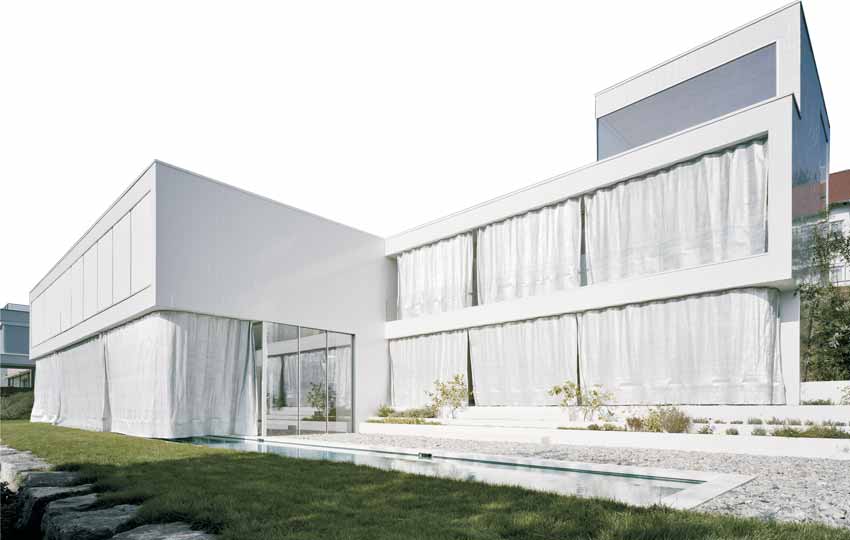
All rooms on both levels are open to the southwest, to countryside with hardly any housing. One doesn't only see fields and meadows but also the weather coming along. Open rooms, a room-high glazing with thin profiles, spaces formed by changing floor levels over the whole width of the living area, spaces which lead into the landscape and also continue the landscape in the interior.
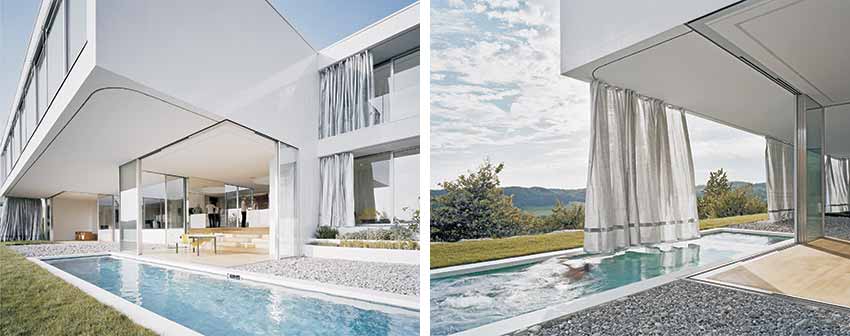
Upon entering the house ones first impression is surprising. Large round skylights lighten the area from above and through an even larger round opening in the floor light reaches a lower level. The light flooding through the openings connects both levels with each other. A yellow bench nestles up to the balustrade. One thing is clear: the cliché of the architects or designer house isn't going to be reproduced here. In the entrance area the floor, walls and built-in wardrobes are all white. One opens the wardrobe doors – they have no handles and open upon pressure – to find the inside is painted in a variety of colors. To the left the lower level is reached over a staircase which is blue-painted and the bedrooms lay alongside. Straight on one reaches the studio which can also be reached directly from the outside by the second entrance.
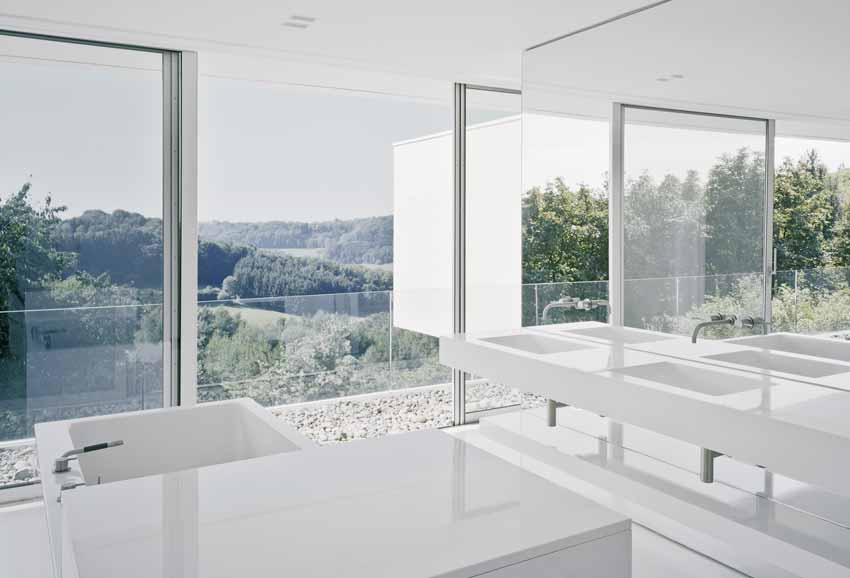
Experiment with Materials
The clients' desire for the best material composition led nowhere not even towards the street - plastered paths or flat terraces; instead there is crude gravel like normally found on the bed of a mountain river. The curtains are made of a silvery shiny material which was developed to cover scaffolding on construction sites. In the living area, the back wall against the ground was constructed by stamping layer over layer of clay. Some of the layers are pigmented lightly so that a picture emerges which resembles a view over the Alb with foggy valleys. Architects have taken full advantages of their client's openness and also use it playfully and tactfully.
The house is an experimenting field. Conventions of living as well as architectural conventions "how things have always been done" were abandoned. But a game wouldn't be a game if it weren't taken seriously. None of the tiles on the facades were cut. The large mirrors which cover the walls on the garden level between living area and atrium are each out of one piece. The wooden floor made out of Canadian birch is high-quality processed. The wall plaster has a high percentage of clay which works - like the stamped clay wall - humidity regulating. The room-high glazing with its extremely thin profiles is the first of its kind with these dimensions. The balustrade around the skylight in the entrance area is rounded in such a way that it feels good to touch but nothing is laid on top. Everything has a reason; is considered and intended, even if one wouldn't have thought of the solution by oneself.

C18 Architects have designed an exceptional house. A house which gives you lust, makes you lust for living and lust for the countryside. And as unconventional as it may be in the neighborhood - it fits in. It is a known fact that it's not easy to pull the wool over the eyes of people from the Alb. Life was too hard to risk relying on somebody else without question.

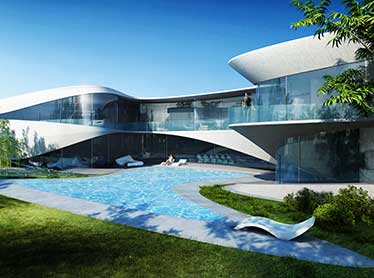
Aqua Villa [Delhi]
With a design philosophy to create integrated design solutions imbibing amalgamated, efficient, robust, and sustainable designs leading to performative architecture, Studio Symbiosis, an architectural & interior design studio based in Delhi, London and Stuttgart has come up with a magnificent design of a Villa, located in the heart of Lutyens Delhi. The practice believes that, with computational tools, it is possible to create elegant design solutions driven by performance.

Aqua Villa has been designed as a sensitive building, sitting in harmony with its surroundings. The design is an outcome of overlap and interaction of the design parameters of movement patterns, solar studies, soft-subtle transition zones, interaction of built and landscape and of the old and the new.
The design form emerges and flows out of the existing building. The lines of the first floor bridge connection to the existing house emanate and disperse on the site.

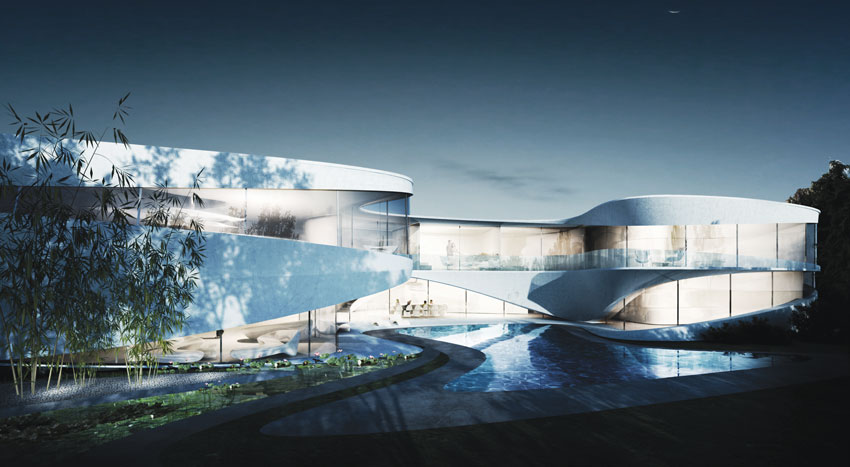
| Location: | New Delhi |
| Built up Area: | 680sqm |
| Site Area: | 1290 sqm (excluding existing villa) |
| Architecture/Landscape: | Studio Symbiosis |
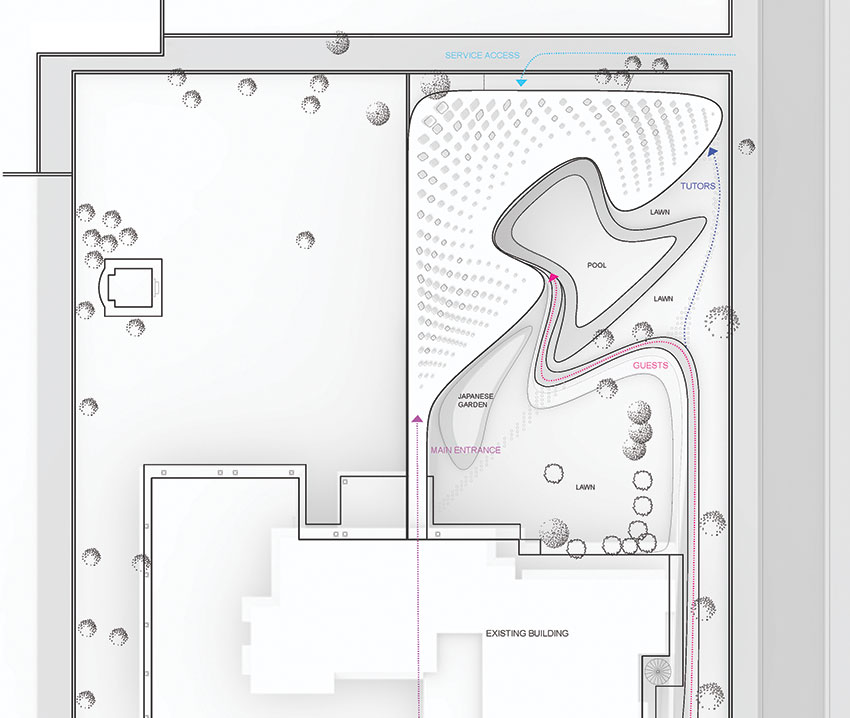
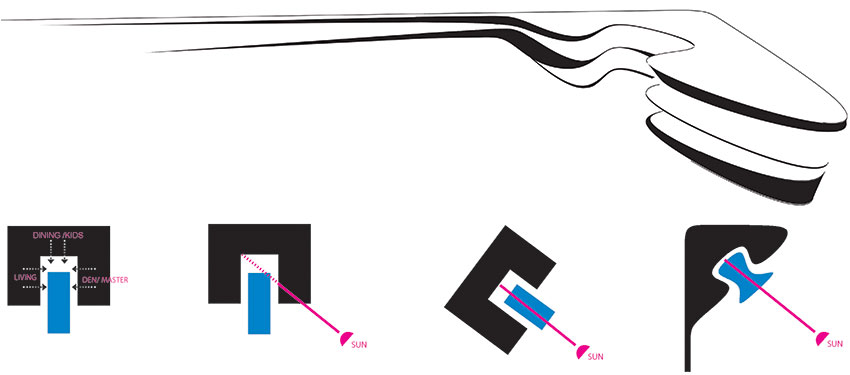
Interlocking Spaces
Aqua villa has a swimming pool sitting amidst the design. It creates a soft transition zone between the proposed villa, the landscape and the existing house, modulating and amalgamating these varied elements into one interlocking system.
Movement Patterns
The movement patterns lead to a three point access to the proposal. The first one is through a covered walkway connecting the existing house to the new one with a water wall along the transition space. The second connection is for guests coming in evening from the side walkway which travels along the landscape and creates a more semi private entrance to the building. The third is a service entry for the staff and nanny from the north east boundary of the proposal, which ensures there is no cross movement of the staff through the villa.
Elegance
The façade is designed in a way that it continues from the existing building and then starts to respond to the program of the new building. A sense of elegance has been imbibed in the façade of the building with the lines moving effortlessly over the proposal. Grand glass doors have been integrated into the proposal.
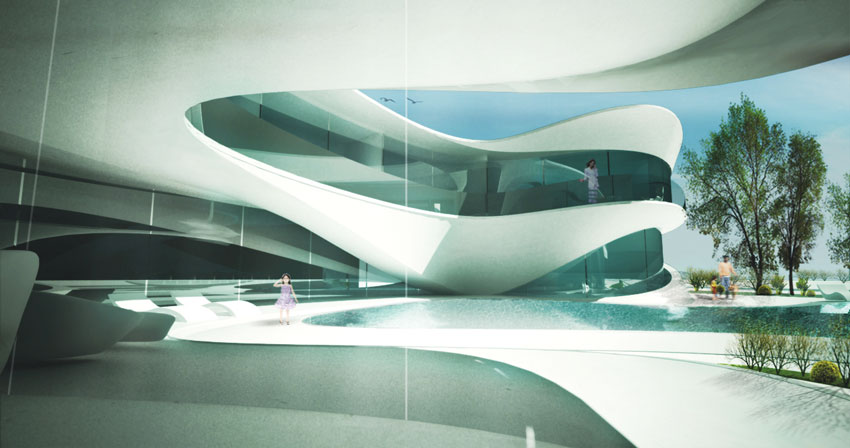
Built-Landscape
The relationship of the built to landscape was very important in the design. The interior spaces flow out onto the landscape on the ground floor and on the upper floors deep luxurious sit out areas overlook the pool / green.
Functional Gradient
The space allocation has been done in a way that there is gradation from public to private. The ground floor has been designed as semi private while the first floor is completely private.
Transformational Spaces
In an event of a gathering, the spaces on the ground floor open up and work in coherence with each other to create one grand experiential space.
Sustainability Integrated
Solar studies have been an integral part of the design process to achieve ambient light and shadow condition on the sundeck and inside the villa.The pool centered in the courtyard is creating evaporative cooling in summer. Balcony cantilever depth depending on summer sun angle to shade direct sun light and to let the winter sun in during the cold winter season.
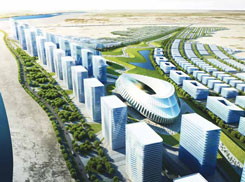
Kanpur Riverfront Development [Uttar Pradesh]

| Architects | : Studio Symbiosis |
| Location | : Kanpur, India |
| Partners | : Amit Gupta and Britta Knobel Gupta |
| Area | : 1156 Acres |
| Year | : 2013 |
Ganga provides the most influential and dominant context for the master plan. The existing patterns of Ganga were studied and through digital simulation density patterns emulating the Ganga patterns were translated into the central green of the master plan. This central green area gives the master plan a distinct character and acts as breathing lungs for the city.
Auto expo is located at the heart of the master plan, sitting amidst the central green. It is located at a very important interface of the central green and the promenade. It's an amalgamation zone of various activities of the master plan cascading into each other thereby creating a functionally rich urban plaza.

Ahmedabad Hotel [Gujarat]
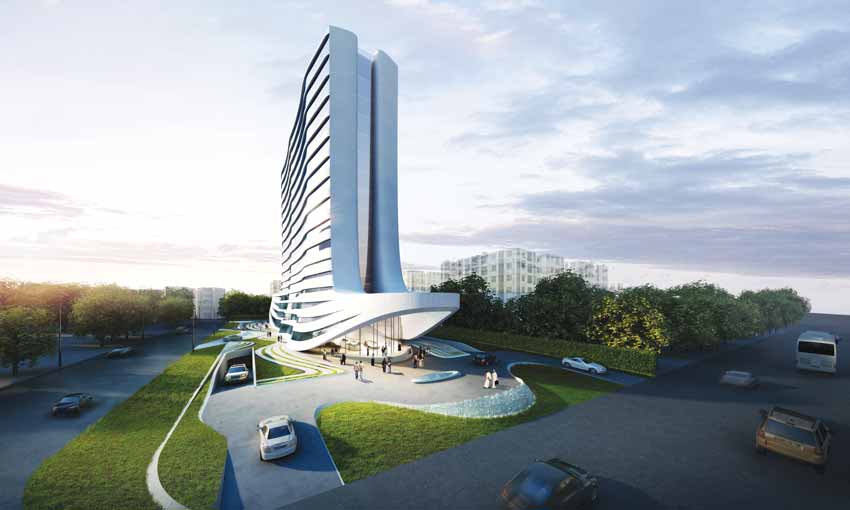
| Architects | : Studio Symbiosis |
| Location | : Ahmedabad, Gujarat, India |
| Partners | : Amit Gupta, Britta Knobel Gupta, Vandana Sehgal (Hon.) |
| Site Area | : 6860 sqm |
| Built-up Area | : 24,000 sqm |
| Completion | : June 2015 |
The idea of creating a design with soft subtle touches and imbibing a sense of elegance has been instilled in the proposal from the creation of the form itself. The different functions in the building with different programmatic requirements are blending together thus resulting in this iconic building. The building comprises three waves which are very carefully translated into dramatic key spaces on the lower floors, and on the upper floors they translate into room grids with focus on standardized room sizes.
These waves emerge effortlessly from the landscape creating a sense of harmonic relationship with the ground. The profile of the building has been designed with keen emphasis given both to the smooth transition from the horizontal landscape to the vertical building and to the standardization and repetition of the façade components.

Master Plan for ‘New Allahabad’

| At a Glance | |
| Project | : Allahabad Masterplan, Allahabad, State U.P., India |
| Architect | : Studio Symbiosis |
| Partners | : Dr. Vandana Sehgal (Hon.), Britta Knobel Gupta, Amit Gupta |
| Client | : UPSIDC |
| Site Area | : 1500 Acres |
The proposal was to design a new township on the pattern of Sangam -- convergence and unity -- with ample area demarcated for industries and institutions. The Architectural firm proposed a plan for an area of 1,500 acres that includes 32% industrial area, 24% residential, 16% green and over 9% has been earmarked for institutions while the rest for mixed use, transport and public amenities. The township is planned to be developed with world-class infrastructure catering to all needs of industries and residents. There would be zero discharge mechanism for water conservation and waste management. The proposed township would be self-reliant in energy with separate transport networks, easily accessible bus stands and cycle tracks.

Design: Reconceiving Sangam
The master plan by Studio Symbiosis takes into account the single most important feature of the city "Sangam". It is the meeting point of the three holy rivers of India; Ganga, Yamuna and Sarasvati. It's not just a spiritual marker but also a significant geological phenomenon and defines unity and amalgamation.The concept of "Sangam" has been integrated in the master plan as a diagram of connectivity and unity. The universal symbol of unity creates a continuous loop defining three zones. These zones depicting the trinity have been inscribed as a formal as well as a programmatic element of the master plan. It is grafted in the heart of the master plan and acts as a melting point for the city as a commercial and recreational hub.
The site is interrupted due to the existing settlements and ponds that cannot be moved. The design creates a sweeping gesture combining the site into one entity and still accommodating the villages on the site. This results in creating a comprehensive connected scheme.
Amalgamation
The brief requires a mixed use master plan consisting of Industries, Residential, Housing, Institutional, Commercial and Mixed use. The various typologies have been morphed from one to another and correspond to the zoning. This results in an amalgamated master plan design whereby the perception during movement is a gradual change in the form resulting in a sense of unity of the diverse typologies.The built and the green have been designed as one system. Green network and the built environment are integrated into one, which seamlessly flows on the site. This unified system of built and green was important to create a city level and neighborhood green, which creates a sense of living within the nature in the master plan along with a layer of pedestrian network.

The star form of the green transforms from un-built to the built feature of the buildings in the central Sangam area, along with the neighborhood green morphing into urban green plazas. The functional diversity has been unified by a seamless skyline. This undulating skyline merges the various functional requirements of the master plan into a visually coherent system.
The master plan is designed as a Sustainable master plan and a zero discharge city. At the planning stage, the green percentage, porosity of the materials, transportation network and walking distances have been accounted for. In the second stage of the design, implementation elements of Energy, Water and Waste management systems have been embedded in the planning bylaws.
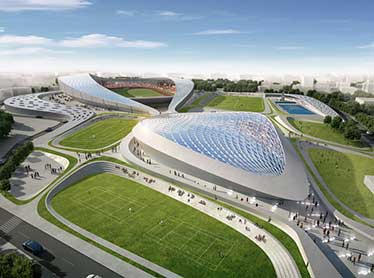
Athletic Ripples: Mixed Use Sports Architecture
| Architects | Studio Symbiosis |
| Partners | Amit Gupta and Britta Knobel Gupta |
| Client | Navodaya Vidyalaya Samiti |
| Site Area | 1,00,000 sqm |
| Built up Area | 31,000 sqm |

According to Architects Amit Gupta and Britta Knobel Gupta, "Athletic Ripples" is a project based on interfacing the user and his built environment into a coherent whole. The program has been translated into trajectories of movement. These flow lines generated the formal idea which is underlined by interweaving of the various activities. This results in creating a design with an inherent quality of interaction.
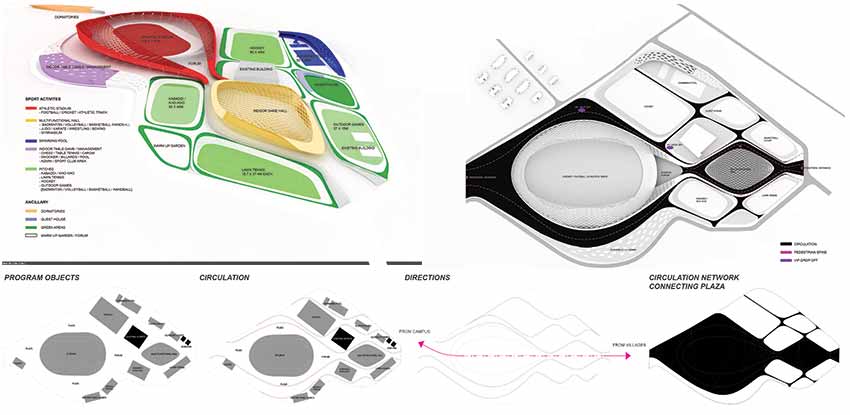
Each section of the project contains a different sporting activity space, individually designed in a range of varying forms and styles, each is loosely moulded on the concept of ripples in water. The firm defines, "Conceptually these programmatic zones were treated as pebbles dropped in water. It is the inference of the water field, thus creating ripples giving a guideline for the formal design language of the project." The 'droplets' vary in size, design and purpose, but Studio Symbiosis unified each section by designing them to symbolize individual pebbles in a pond.
The program asks for a stadium which accommodates cricket pitch, football ground and an athletics running track. Along with this function, a number of indoor outdoor sports activities are located on site as required by the brief.
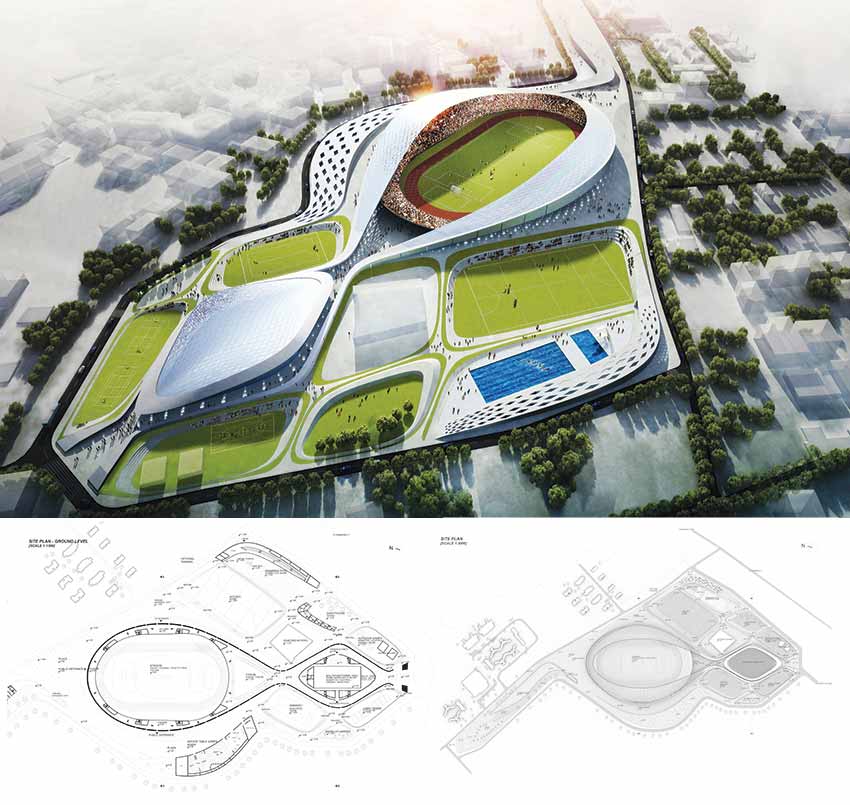
Special emphasis has been laid during design process to minimize the congestion. The central pedestrian zone caters for the primary movement on site. This linear zone has been kept exclusively for the pedestrians, thereby instilling the feeling of being in a green sports complex. It has been attempted to eliminate the dogma of vehicular congestion related to projects like this. This corridor being axial in nature branches into different activities.
A continuous silhouette has been designed for the project. As a design outlook, it has been taken into account that being a sports complex, an atmosphere of being nested in nature is created. The built form does not sit in disjunction with the surroundings, but on the contrary, flows out of the landscape itself.

Piezoelectricity is being looked to be applied on the landscape pavers. The system will harvest the kinetic energy generated by crowds in areas of heavy foot traffic.
The sports center also boasts an impressive roster of sustainable and energy-efficient building strategies. Solar cells are proposed for the roof of the stadiums to harness the abundantly available solar energy. These solar cells would be integrated on the roof of the stadium as a design element and only a certain percent of the roof panels will be designed as solar panels. There is a proposed mix of solar panels and pneumatic panels on the roof to maintain the required light intensity inside the stadium.

